Richard Winton
Los Angeles Times
Tue, 01 Jul 2008 19:50 EDT
Witnesses across Southern California say they saw an object
'moving very fast across the northern sky' and falling near the San
Bernardino Mountains. Officials have no firm answers on what it was.
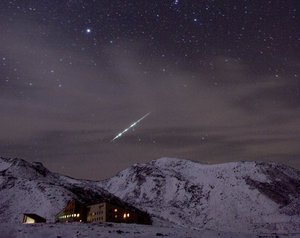 |
| ©LA Times |
From Hollywood Hills to the Nevada state line, people reported
seeing a fireball streaking across the sky and falling near the San
Bernardino Mountains this morning. But explanations of the mysterious
object were scarce.
San Bernardino County Fire Dispatch reported receiving dozens of
calls related to what was described as fireball moving at high speed
and falling in northwest sky around 10:40 a.m.
"We got quite a few reports. It started with a gentlemen in the Lake
Arrowhead reporting a fireball in the Meadow Bay area and then we
started getting calls from all over," said San Bernardino County
dispatch supervisor Tom Barnes. "Fire crews in Barstow and on I-15 near
Stateline came up on the radio and reported an object in the sky moving
very fast across the northern sky and described it as yellowish green
in color with streaks of debris. It looked like it burned up before it
hit the ground."
Barnes said the department has "basically determined it was most
likely not an aircraft and was probably man-made or a meteor entering
the Earth's atmosphere."
Meteors and meteorities are small rocky fragments of other planetary
bodies that fall to Earth. A fireball is one of a most common class of
meteor, named because they are bright, streaming orbs. They decelerate
from 60,000 mph to 200 mph and often fall to earth or don't survive the
journey.
Some very bright fireballs can be seen in the day, experts say.
Studies have indicated that about 25 meteorities weighing more than
fifth of a pound fall on an area the size of California annually.
Caltech experts say about 300 to 400 larger meteorites fell in
California during the last century.
John Haire, chief of media relations for Edwards Air Force Base,
said the base did not conduct any tests and he knew nothing about the
event. "I thinks some people have been watching too much "X-Files," he
said, referring to the popular show about FBI agents investigating
phenomena that had no conventional explanation.
Most of the reports were in Riverside and San Bernardino, but a few
people reported seeing the fireball as far west as the Hollywood Hills.
Federal Aviation Administration spokesman Ian Gregor said the FAA
had no reports of any missing or down aircraft and the military had not
informed the agency of any problems with aircraft or missiles.
The Barstow Fire Protection District dispatched firefighters to near
the town of Calico but found no evidence of a meteorite or anything
else hitting the ground, officials said.
On rimoftheworld.net, which covers the San Bernardino mountain area,
those monitoring local rescue aircraft frequencies reported hearing a
fire attack plane detect an emergency beacon near Butler Peak in the
Big Bear area. But no signs of any downed aircraft were found.
Earth Not Ready for Meteors or Comets
Brian Handwerk
National Geographic
Tue, 01 Jul 2008 23:23 EDT
A hundred years after a mysterious and massive explosion struck
Russia, experts are warning that Earth is ill prepared to face a cosmic
catastrophe that could do similar damage.
The blast, known as the Tunguska event, leveled some 770 square
miles (2,000 square kilometers) of forest with the power of nearly 200
Hiroshima-size atomic bombs.
Remarkably few people witnessed the event, and debate has raged for decades about its cause.
One of the leading theories is that a comet or asteroid hit Earth or
exploded upon entering the atmosphere above remote western Siberia.
"Had that same object exploded over a metropolitan area, there would have been millions of people killed,"
U.S. Representative Dana Rohrabacher (a Republican from California)
said yesterday at a briefing at the Planetary Society in Pasadena,
California.
"Right now we have no plan in place to detect these objects far enough out to deflect them."
Odds Are Slim
Meteors in the form of about a hundred tons of dusty particles reach Earth every day.
In fact meteors seen on an average night or during an annual shower
are mostly small particles burning up as they enter our atmosphere.
Because Earth is pelted with tiny objects all the time, assessing
the probability of larger impacts is far more difficult and
controversial.
Experts admit they don't yet know how many so-called Near-Earth Objects (NEOs) orbit close enough to pose a threat.
Most NEOs are asteroids, and NASA currently classifies about 959 asteroids as potentially hazardous.
To qualify, the bodies must be at least 500 feet (150 meters) wide
and be capable of approaching Earth within 4.7 million miles (7.5
million kilometers).
By some accounts, the object that might have caused the Tunguska
blast was not particularly large in the world of NEOs, highlighting the
fact that larger objects need not hit populated areas to cause damage.
On average, mid-size meteor strikes occur once every 300 years, NASA estimates.
What's more, only a tiny fraction of Earth's surface is heavily
populated, and about 70 percent is covered with water. So the odds of a
direct strike on a populated area remain quite remote.
Still, meteorites that splash down in oceans can cause tsunamis. And
land impacts even in remote locales can raise debris and dust that may
alter climate by blocking sunlight and spawning acid rain.
"The chances are not large, but they are not zero either," said
William Ailor, an NEO expert with the Aerospace Corporation, a
federally funded research center in El Segundo, California.
Under the Radar
Alan W. Harris of the Space Science Institute in Boulder, Colorado,
has participated in numerous studies supported by NASA to evaluate the
NEO hazard.
He reported that impacts capable of causing global climate disasters
that could claim a billion lives are likely to happen once every
million years.
And once every billion years or so the possibility exists for a massive asteroid impact to wipe out much of the life on Earth.
Harris noted that survey work on large NEOs - those greater than 0.6
miles (a kilometer) in diameter - during the last decade has ruled out
such apocalyptic events in the foreseeable future.
"The good news is we have conducted the 'Spaceguard' survey, which has detected most of these very large objects," he said.
"We think we've detected all the NEOs big enough to cause a mass extinction and pretty much eliminated that risk."
Meanwhile smaller objects that can cause significant destruction are currently flying under the radar.
That's why Rohrabacher and the Planetary Society have called for
increased federal funding to find and track dangerous NEOs and develop
strategies to deflect them.
"We now have the technology to prevent the next [strike]," said
Ailor, the Aerospace Corporation's NEO expert. "But we have to be
looking for it, and we're not looking at things that small."
Many NEO experts stress that the National Science Foundation's
Arecibo Observatory in Puerto Rico is key to finding and tracking
potential Earth-bound objects.
NEO hunters such as Don Yeomans, manager of NASA's Near-Earth Object
Program Office at the Jet Propulsion Laboratory in Pasadena,
California, say that Arecibo is critical to their work.
It's not enough to know that an asteroid is headed toward Earth, Yeomans said.
"You have to know how big it is, its shape, its mass, and its
rotation characteristics," he said. "One of the very few ways you can
do that is with the radio telescope techniques."
But funding cuts mean that the massive radio telescope could soon be shut down.
As for deflecting NEOs that pose a threat, most experts agree that decades of lead time will be key to dealing with the problem.
"The main risk lies with those objects that we have not even found yet," the Space Science Institute's Harris said. "So the most important thing is to continue [surveillance]."
Russian expert says nuclear devices can defend against asteroids
RIA Novosti
Tue, 01 Jul 2008 14:36 EDT
Nuclear explosive devices are the most effective means of protecting
Earth from possible collisions with space bodies, including comets and
asteroids, a Russian nuclear physicist told RIA Novosti on Tuesday.
Scientists around the world have long been seeking means of
protecting the Earth from the threat of dangerous Near Earth Objects
(NEOs). Scientists say such collisions pose a threat on average once
every 200-1,000 years.
Vadim Simonenko, deputy head of the Russian Federal Nuclear Center,
believes that nuclear explosive devices are more energy efficient,
compact and less heavy than lasers or the so-called "gravitational
tractors" in terms of their practical application as "weapons against
NEOs."
"We in Russia have a wealth of experience in the controlled use of
nuclear explosions for peaceful purposes," Simonenko said. "A nuclear
device in skilful hands is like a scalpel in the hands of a surgeon."
The scientist said special nuclear devices must be created for
effective use against NEOs. In order to disperse an asteroid with
diameter of up to 100 meters, these devices must have a yield of about
one megaton of TNT equivalent, and weigh several hundred kilograms.
"It is a difficult technical task but it can be accomplished.
Besides, there is no need for actual testing [of these devices] because
it may be done through computer modeling," he said.
Existing nuclear devices, both military and civilian, were created
for specific purposes and do not meet the requirements for "precision
strikes" against NEOs, especially comets, which are less predictable
than asteroids, Simonenko said.
An earlier report at a Moscow scientific conference said 99942
Apophis, or Asteroid 2004 MN4, with a diameter of 350 meters, currently
poses biggest space threat to Earth.
In 2029, this NEO will be at a distance of only 36,000 km (22,400
miles) - closer than satellites in geostationary orbit. Earth's gravity
could alter the path of Apophis in such a way that it would collide
with Earth on its next approach in 2036.
The explosion could surpass the famous Tunguska explosion of June
30, 1908, which affected a 2,150 square kilometer (830 sq miles) area
of Russia felling over 80 million trees in the Krasnoyarsk Territory in
Siberia.
Some researchers believe, however, that blowing up NEOs in space
poses could result in large fragments surviving the fiery passage
through the atmosphere and still hitting the planet.
They propose a more cautionary approach toward dealing with NEOs, by deflecting them from their collision path toward the Earth.
"Deflection is the most favorable strategy, but it requires a
considerable early warning period - up to a few years," Simonenko said.
"We may not have such a luxury because small asteroids [100-150 m in
diameter] are hard to detect."
Press Release Newswire
Tue, 01 Jul 2008 12:16 EDT
One hundred years ago, a large asteroid or comet exploded over
sparsely populated Tunguska in Siberia. Ash soared 40 miles high and
spread around the world, causing atmospheric, seismic, and magnetic
disturbances worldwide. A drought ensued in northern Michigan that led
to a devastating two-million-acre wildfire. The historical novel "Devil in the North Woods" suggests a possible connection between these events.
Lake Linden, MI -- July 1, 2008 -- You may have heard of the June
30, 1908, explosive event that took place over Tunguska in the remote
interior of Siberia. But have you heard about the two-million-acre wildfire that incinerated that huge chunk of northeastern Michigan's farm and timber land in October of 1908? A century later, does the evidence indicate a possible connection?
In the prologue of the 2005 historical novel "Devil in the North Woods," author Walt Shiel suggests just that:
The Sky Splits Apart
On June 30, 1908, a 100,000-ton meteorite or comet plunged to Earth
above the sparsely populated tundra of Siberia. Angled 30 degrees to
the horizon, it ripped through the atmosphere from southeast to
northwest at 50 times the speed of sound and exploded four miles above
the ground with the force of a 40-megaton nuclear bomb. Ash and
pulverized debris soared 40 miles high and spread around the world,
causing brilliant sunsets and sunrises as far away as Western Europe,
glowing night skies bright enough to read by over much of the Earth,
and seismic and magnetic perturbations 2500 miles from the explosion's
epicenter.
A month later in North America, following an early wet spring,
northern Michigan plunged into an extended drought that left the dense
underbrush in the virgin forests dry, brittle, and flammable, perfect
conditions for a rash of forest fires.
Was the extraterrestrial visitor connected to the Michigan drought
and wildfires? We will never know for sure, but we do know that
Michigan's weather that fall took a sudden, unexpected shift.
On this 100th anniversary of the Tunguska event, we should remember
that is the only event of its kind in human history for which we have
recorded eyewitness accounts. As Don Yeomans, manager of the Near-Earth
Object Office at NASA's Jet Propulsion Laboratory, says: "On average, a Tunguska-sized asteroid will enter Earth's atmosphere once every 300 years.
Comment: Now, remember that's an average.
And, 100 years after the Metz, Michigan, wildfire, we are all watching the wildfires raging through northern California. "Devil in the North Woods"
tells the true story of the Metz fire and how the farmers, loggers, and
merchants fought to survive without the benefits of advance warnings or
modern firefighting equipment.
The Midwest Book Review said that Shiel's book "vividly
recreates the terrible blaze from start to finish, the toll it took,
and the trials of human beings forced to recover from the devastating
losses it inflicted. Through telling the story of man vs. nature, its
core is emotional and human-centered." And the Historical Novel Society
noted that the "compassionate writing creates a community of bright,
supportive, and determined people, whose characters develop and deepen
as the fire grows."
Walt Shiel has been freelancing for magazines in the U.S. and abroad for two decades and has written four books, including "Devil in the North Woods," two military history books, and a collection of short stories.
Life Altered 12, 900 Years Ago By A Giant Comet?
Science Daily
Wed, 02 Jul 2008 16:52 EDT
Geological evidence found in Ohio and Indiana in recent weeks is
strengthening the case to attribute what happened 12,900 years ago in
North America -- when the end of the last Ice Age unexpectedly turned
into a phase of extinction for animals and humans - to a cataclysmic
comet or asteroid explosion over top of Canada.
A comet/asteroid theory advanced by Arizona-based geophysicist Allen
West in the past two years says that an object from space exploded just
above the earth's surface at that time over modern-day Canada, sparking
a massive shock wave and heat-generating event that set large parts of
the northern hemisphere ablaze, setting the stage for the extinctions.
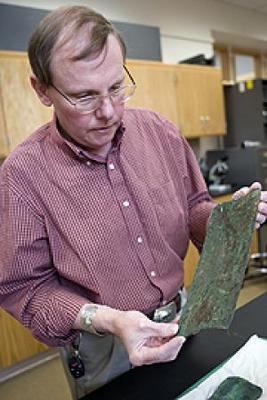 |
| ©University of Cincinnati |
| Ken Tankersley. |
Now University of Cincinnati Assistant Professor of Anthropology Ken
Tankersley, working in conjunction with Allen West and Indiana
Geological Society Research Scientist Nelson R. Schaffer, has verified
evidence from sites in Ohio and Indiana - including, locally, Hamilton
and Clermont counties in Ohio and Brown County in Indiana - that offers
the strongest support yet for the exploding comet/asteroid theory.
Samples of diamonds, gold and silver that have been found in the
region have been conclusively sourced through X-ray diffractometry in
the lab of UC Professor of Geology Warren Huff back to the diamond
fields region of Canada.
The only plausible scenario available now for explaining their
presence this far south is the kind of cataclysmic explosive event
described by West's theory. "We believe this is the strongest evidence
yet indicating a comet impact in that time period," says Tankersley.
Ironically, Tankersley had gone into the field with West believing he might be able to disprove West's theory.
Tankersley was familiar through years of work in this area with the
diamonds, gold and silver deposits, which at one point could be found
in such abundance in this region that the Hopewell Indians who lived
here about 2,000 years ago engaged in trade in these items.
Prevailing thought said that these deposits, which are found at a
soil depth consistent with the time frame of the comet/asteroid event,
had been brought south from the Great Lakes region by glaciers.
"My smoking gun to disprove (West) was going to be the gold, silver
and diamonds," Tankersley says. "But what I didn't know at that point
was a conclusion he had reached that he had not yet made public - that
the likely point of impact for the comet wasn't just anywhere over
Canada, but located over Canada's diamond-bearing fields. Instead of
becoming the basis for rejecting his hypothesis, these items became the
very best evidence to support it."
Additional sourcing work is being done at the sites looking for
iridium, micro-meteorites and nano-diamonds that bear the markers of
the diamond-field region, which also should have been blasted by the
impact into this region.
Much of the work is being done in Sheriden Cave in north-central
Ohio's Wyandot County, a rich repository of material dating back to the
Ice Age.
Tankersley first came into contact with West and Schaffer when they
were invited guests for interdisciplinary colloquia presented by UC's
Department of Geology this spring.
West presented on his theory that a large comet or asteroid,
believed to be more than a mile in diameter, exploded just above the
earth at a time when the last Ice Age appeared to be drawing to a close.
The timing attached to this theory of about 12,900 years ago is
consistent with the known disappearances in North America of the wooly
mammoth population and the first distinct human society to inhabit the
continent, known as the Clovis civilization. At that time, climatic
history suggests the Ice Age should have been drawing to a close, but a
rapid change known as the Younger Dryas event, instead ushered in
another 1,300 years of glacial conditions. A cataclysmic explosion
consistent with West's theory would have the potential to create the
kind of atmospheric turmoil necessary to produce such conditions.
"The kind of evidence we are finding does suggest that climate
change at the end of the last Ice Age was the result of a catastrophic
event," Tankersley says.
Currently, Tankersley can be seen in a new documentary airing on the National Geographic channel. The film "Asteroids" is part of that network's "Naked Science" series.
The new discoveries made working with West and Schaffer will be
incorporated into two more specials that Tankersley is currently
involved with - one for the PBS series "Nova" and a second for
the History Channel that will be filming Tankersley and his UC students
in the field this summer. Another documentary, this one being produced
by the Discovery Channel and the British public television network
Channel 4, will also be following Tankersley and his students later
this summer.
As more data continues to be compiled, Tankersley, West and Schaffer
will be publishing about this newest twist in the search to explain the
history of our planet and its climate.
Climate change is a favorite topic for Tankersley. "The ultimate
importance of this kind of work is showing that we can't control
everything," he says. "Our planet has been hit by asteroids many times
throughout its history, and when that happens, it does produce climate
change."
Adapted from materials provided by University of Cincinnati.
Lucas Lukumbo
Sunday Observer
Sun, 29 Jun 2008 03:56 EDT
A Tanzanian renowned physicist cum astronomer, Dr Noorali Jiwaji has
challenged the government to work out modalities for scientific study
of a rare type of meteorite which scientists say landed in Tanzania in
1938.
Dr Noorali Jiwaji who is a Lecturer in Physics and Head of
Department of ICT in the Faculty of Science Technology and
Environmental Studies at the Open University of Tanzania (OUT) has said
Tanzania has competent chemists, biochemists and geologists to
undertake the research.
He was responding to questions from this reporter in an exclusive
interview on the a rare type of meteorite, labeled Ivuna meteorite,
which scientists say could hold clues to the birth of our solar system.
''The meteorite has a knowledge value. We could understand the
process by which the solar system was formed, including the initiation
of life.
It has been found to contain some amino acids, the building blocks from which living things are made,'' he said.
He said the fact that Ivuna meteorite was found in the 1938 and was
well preserved to prevent deterioration for the past two or three
decades, our own samples also need to be preserved to enable future
scientific research.
Dr Jiwaji also called for Tanzania to use astronomy as a tourist attraction saying that Tanzania has unique skyline.
''We are at the equator where you can see almost all the stars, and we have no light pollution.
We have dark skies where numerous stars are vividly seen unlike in
many developed countries where the skies are extremely polluted by the
bright lights that leaks upward into space,'' he stressed adding, ''we
could train star tour guides to cater for the astronomy tourism.''
According to the expert, meteorites are bodies that fall on earth
from space. They originate from the asteroid belt between the orbit of
Mars and Jupiter.
There are millions of pieces around the sun in the area and that due
to gravitational pull of the planets, once in a while are attracted
towards the earth.
He said 200 tons of material falls on to the earth each day from space, most of it in the form of small particles or dust.
Most of this material burns up when heated by friction with the
thick atmosphere that surrounds us. Shooting stars that we see during
the night are best example of such burning bodies.
Large bodies however do not burn up completely and fall to earth as meteorites.
The Mbozi meteorite near Mbeya in Southern Tanzania is a huge piece
of mainly iron weighing 16 tonnes is among the top ten largest
meteorites to fall on earth.
The largest is the Hoba meteorite in Namibia weighing nearly 70 tonnes.
The Ivuna meteorite is a typical example of meteorites originating
in the primordial material from the outer fringes of our solar system,
and from which the sun and the solar system have formed.
The material of the sun is composed of hydrogen, helium and interstellar (between stars) dust.
When the primordial material from the edge of our solar system nears
earth it is sometimes seen as comets with long tails formed by its dust
pushed away by sunlight.
The Ivuna meteorite is one such piece that was trapped by the earth's pull and fell near Mbeya in 1938 weighing about one kilo.
According to sources most Ivuna samples are held in private
collections and by Tanzanian government. Its chemical make-up, which
matches that of the sun, is extremely rare- just nine of the 35,000
known meteorites or 0.03 percent have this solar composition.
A meteorite curator at the Natural History Museum in London told the
media that these types of meteorite are very susceptible to alteration
on Earth. Changes in humidity for example could change their
composition.
In 2009 the world will celebrate the International Year of Astronomy
to commemorate the 400th anniversary of Galileo's first use of a
telescope to study the night sky.
Astronomers around the world will be inviting people to look up in
wonder at the night sky, and to seek out answers to some of life's
biggest questions about our universe and its origins.
The theme of the years is ''The Universe -Yours to discover.''
Dr Caroline Smith unveils the Ivuna meteorite
A rare type of meteorite that could hold clues to the birth of our
Solar System has been bought by London's Natural History Museum.
The Ivuna meteorite, obtained from a US private collection, has the
same chemical make-up from which the Solar System formed 4.5 billion
years ago. It landed in Tanzania in 1938 as one 705g stone, since split
into samples.
Pieces from the UK sample, the largest in any public collection in the world, will be removed for study.
Most Ivuna samples are held in private collections, or by the
Tanzanian government. It's a particularly important specimen to science
because it's been so well preserved.
Dr Caroline Smith, meteorite curator at the Natural History Museum
(NHM), told BBC News: ''These types of meteorite are very susceptible
to alteration on Earth. Changes in humidity, for example, can change
their composition.
''But this meteorite is important as it fell relatively recently and
has been kept under nitrogen in a sealed environment for the last two
or three decades.
''It's a particularly important specimen to science because it's
been so well preserved. We're all incredibly excited about it because
it's so pristine.''
Monica Grady, professor of planetary sciences at the Open University
in Milton Keynes, commented: "This is fantastic for the UK's meteorite
experts.
This material represents the crumbs from the foundation of the Solar
System. It's an unbelievable opportunity to study it in close-up. The
museum has been very bold in acquiring it.''
One question that Ivuna could help answer is how the chemical
building blocks for life came to Earth. Important components of
so-called pre-genetic material, the amino acids b-alanine and glycine,
were found in Ivuna in a 2001 study.
Scientists at Imperial College London have confirmed that a
meteorite called Murchison contained extra-terrestrial molecules that
were the precursors to DNA and RNA.
In addition to being used for research, Ivuna will be a star
specimen in a new meteorites gallery, which the NHM is planning for the
near future.
''The plan is to take the meteorite to Nasa's Johnson Space Center
in Houston, where we'll have a 20g piece taken off and that will be
sub-divided into two 10g pieces,'' Dr Smith explained.
''One piece will be put to one side. The other will be divided into
200mg allocations - less than the size of your fingernail - for
researchers to study."
Exploding Asteroid Theory Strengthened By New Evidence Located In Ohio, Indiana
Science Daily
Wed, 02 Jul 2008 18:47 EDT
Geological evidence found in Ohio and Indiana in recent weeks is
strengthening the case to attribute what happened 12,900 years ago in
North America -- when the end of the last Ice Age unexpectedly turned
into a phase of extinction for animals and humans - to a cataclysmic
comet or asteroid explosion over top of Canada.
 |
| ©University of Cincinnati |
| Ken Tankersley |
A comet/asteroid theory advanced by Arizona-based geophysicist Allen
West in the past two years says that an object from space exploded just
above the earth's surface at that time over modern-day Canada, sparking
a massive shock wave and heat-generating event that set large parts of
the northern hemisphere ablaze, setting the stage for the extinctions.
Now University of Cincinnati Assistant Professor of Anthropology Ken
Tankersley, working in conjunction with Allen West and Indiana
Geological Society Research Scientist Nelson R. Schaffer, has verified
evidence from sites in Ohio and Indiana - including, locally, Hamilton
and Clermont counties in Ohio and Brown County in Indiana - that offers
the strongest support yet for the exploding comet/asteroid theory.
Samples of diamonds, gold and silver that have been found in the
region have been conclusively sourced through X-ray diffractometry in
the lab of UC Professor of Geology Warren Huff back to the diamond
fields region of Canada.
The only plausible scenario available now for explaining their
presence this far south is the kind of cataclysmic explosive event
described by West's theory. "We believe this is the strongest evidence
yet indicating a comet impact in that time period," says Tankersley.
Ironically, Tankersley had gone into the field with West believing he might be able to disprove West's theory.
Tankersley was familiar through years of work in this area with the
diamonds, gold and silver deposits, which at one point could be found
in such abundance in this region that the Hopewell Indians who lived
here about 2,000 years ago engaged in trade in these items.
Prevailing thought said that these deposits, which are found at a
soil depth consistent with the time frame of the comet/asteroid event,
had been brought south from the Great Lakes region by glaciers.
"My smoking gun to disprove (West) was going to be the gold, silver
and diamonds," Tankersley says. "But what I didn't know at that point
was a conclusion he had reached that he had not yet made public - that
the likely point of impact for the comet wasn't just anywhere over
Canada, but located over Canada's diamond-bearing fields. Instead of
becoming the basis for rejecting his hypothesis, these items became the
very best evidence to support it."
Additional sourcing work is being done at the sites looking for
iridium, micro-meteorites and nano-diamonds that bear the markers of
the diamond-field region, which also should have been blasted by the
impact into this region.
Much of the work is being done in Sheriden Cave in north-central
Ohio's Wyandot County, a rich repository of material dating back to the
Ice Age.
Tankersley first came into contact with West and Schaffer when they
were invited guests for interdisciplinary colloquia presented by UC's
Department of Geology this spring.
West presented on his theory that a large comet or asteroid,
believed to be more than a mile in diameter, exploded just above the
earth at a time when the last Ice Age appeared to be drawing to a close.
The timing attached to this theory of about 12,900 years ago is
consistent with the known disappearances in North America of the wooly
mammoth population and the first distinct human society to inhabit the
continent, known as the Clovis civilization. At that time, climatic
history suggests the Ice Age should have been drawing to a close, but a
rapid change known as the Younger Dryas event, instead ushered in
another 1,300 years of glacial conditions. A cataclysmic explosion
consistent with West's theory would have the potential to create the
kind of atmospheric turmoil necessary to produce such conditions.
"The kind of evidence we are finding does suggest that climate
change at the end of the last Ice Age was the result of a catastrophic
event," Tankersley says.
Currently, Tankersley can be seen in a new documentary airing on the
National Geographic channel. The film "Asteroids" is part of that
network's "Naked Science" series.
The new discoveries made working with West and Schaffer will be
incorporated into two more specials that Tankersley is currently
involved with - one for the PBS series "Nova" and a second for the
History Channel that will be filming Tankersley and his UC students in
the field this summer. Another documentary, this one being produced by
the Discovery Channel and the British public television network Channel
4, will also be following Tankersley and his students later this summer.
As more data continues to be compiled, Tankersley, West and Schaffer
will be publishing about this newest twist in the search to explain the
history of our planet and its climate.
Climate change is a favorite topic for Tankersley. "The ultimate
importance of this kind of work is showing that we can't control
everything," he says. "Our planet has been hit by asteroids many times
throughout its history, and when that happens, it does produce climate
change."
Strange Asteroid Shapes Explained
Lee Pullen
Live Science
Thu, 03 Jul 2008 16:47 EDT
The asteroids that pepper our solar system come in all shapes, sizes
and ages. What causes such a variety among space rocks has been
something of a mystery, until now.
Researchers have been using a vast database to study a staggering
11,735 asteroids. They have discovered that asteroids change shape over
time, and they think they know the reason why.
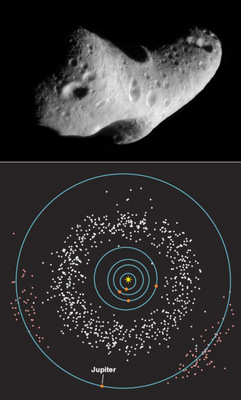 |
| ©Diagram: Minor Planet Center, Image: NASA/Johns Hopkins University Applied Physics Laboratory |
| The main belt is between the orbits of Mars and Jupiter, and contains countless asteroids. |
Gyula Szabó from the University of Szeged [Hungary] is the lead author of the study, which was published in the July edition of Icarus.
He explains, "There are several hundred thousand asteroids in our solar
system. They orbit the sun, but because they are small their surface
gravity is low. This means that many have strange, irregular shapes."
Scientists like Gyula think that about one third of known asteroids
belong to groups called "families." These clusters probably formed from
piles of debris after larger objects collided.
Resolved to save time
Determining the shapes of these asteroids presented difficulties for
Gyula and his colleague Laszlo Kiss from the University of Sydney. The
most accurate data about asteroids comes from spacecraft fly-bys, but
only a few asteroids have been examined that way. Radar observations
can only be made of objects that get close to the Earth. Telescopes
produce detailed images, but only for the largest asteroids.
Another option for obtaining information about asteroids is called
"time-resolved photometry." The technique is surprisingly simple: By
observing asteroids as they spin in space and then studying the amount
of light reflected, scientists can get an idea of their shape. Getting
accurate results from this method can take a long time, but the
researchers realised that digital sky surveys could speed up the
process. Such projects study thousands of objects every night. The
Sloan Digital Sky Survey, for instance, mainly looks at stars and
galaxies, but it also has gathered data on asteroids.
"This procedure was very economical," says Gyula. "Using photometry,
astronomers have determined shapes for about 1,200 asteroids in the
past 30 to 40 years. We derived the shapes for ten times more
asteroids, but in half an hour!"
Surprising results
"The results were really surprising," says Gyula. "We saw there were
families that included many elongated asteroids, and there were other
ones which consisted of mostly spheroidal bodies."
In young groups of asteroids there are a great variety of shapes,
hinting that they formed relatively recently from fragments of rock
that later bound together. Asteroids in older families tend to be
rounder. It seems to take one billion to two billion years for
irregular asteroids to be transformed into smooth balls.
But what changes the asteroids' shape? Gyula and his team have shown
that asteroids change shape from elongated to roughly spherical due to
being impacted during their lifetimes. They are like pebbles on the
beach that become worn smooth over many years -- only in space, erosion
is caused by small impacts as rocks knock into each other and chip
pieces off.
Impact specialist Jonti Horner from the UK's Open University agrees
with Gyula. "The results make sense," he says. "Catastrophic impacts
create a huge slew of fragment shapes, like the shards of a broken
bottle. The debris then are weathered over time and smoothed towards
sphericality by small impacts."
Impacts are part of the fundamental processes in our solar system.
They were part of the planet formation process 4.5 billion years ago,
and still occur today.
"Sometimes astronomers have to be archeologists, too," says Gyula.
"This work is a fine example of how we can deduce a billion-year
process from the world we observe today."
Hopefully, this research will not only teach us more about how the
solar system operates, but will help us prepare for future impact
events. Learning all we can about asteroids could help us avoid
disaster if we ever detect a large, fast-moving one on a collision course with the Earth.
Rosetta awakes from hibernation for asteroid encounter
SpaceRef.com
Thu, 03 Jul 2008 12:30 EDT
Spacecraft controllers have just awoken
Rosetta from hibernation to prepare for its encounter with asteroid
(2867) Steins on 5 September. ESA's comet chaser will study the
relatively rare asteroid as it flies by on its way to comet 67/P
Churyumov-Gerasimenko.
Launched in March 2004, Rosetta will reach its final destination
only in 2014, after travelling a total of about 6500 million km. The
distance between the spacecraft and the Sun as it approaches the comet
will be about 600 million or 4 AU (1 AU or 1 Astronomical Unit is equal
to 150 million km, the mean distance between Earth and the Sun).
Rosetta has swung by Earth twice and Mars once, performing
gravity-assist manoeuvres, that gave it the necessary boost to continue
on its journey. The third and last Earth swing-by is scheduled for
November 2009. The spacecraft will also fly by two asteroids and study
them on the way: (2867) Steins in September this year and (21) Lutetia
in June 2010. As it closes in on (2867) Steins in September, Rosetta
will have travelled about 3700 million km and will be 2.1 AU from the
Sun.
After its last planetary swing-by on 13 November last year, Rosetta
headed towards the asteroid belt located between the orbits of Mars and
Jupiter. On 27 March 2008, the spacecraft switched to its near-Sun
hibernation mode for a period of three months. During this phase, a few
subsystems were put into a dormant state to optimise their lifetime (as
this is only the beginning of the mission's science phase).
Rosetta will be closest to (2867) Steins at 20:37 CEST on 5
September, at a distance of 800 km. The spacecraft will zoom past at a
relative speed of 8.6 km/s.
In preparation for the fly-by, all the instruments will be checked
and tested through the month of July. Between 4 August and 4 September,
spacecraft operators will conduct an optical navigation campaign:
Steins will be tracked by the on-board cameras and the observations
will be used to refine the knowledge of its orbit which has been
derived only from ground-based measurements so far.
Asteroids are samples of the Solar System's material at different
stages of evolution, and studying them helps scientists understand the
origin and evolution of Earth and of our planetary neighbourhood.
(2867) Steins is a relatively rare type of asteroid. Based on
ground-based observations it has been classified as an E-type asteroid,
composed mainly of silicates and basalts, but its properties are not
known in detail. For these reasons, it has been selected as one of the
two asteroids that Rosetta will study, from among those that were
within reach of the mission. The knowledge gained from the measurements
will add to our knowledge of the composition and evolution of E-type
asteroids and will also supplement and help interpret future
ground-based data on asteroids.
The observations will be used to characterise the asteroid and its
environment and to test Rosetta's instruments, most of which will be
active during the fly-by.
The science objectives of the fly-by observations are as follows:
To characterise the asteroid by studying its physical and chemical properties
To study its kinematic properties (its rotation, for example)
To study the asteroid's surface and to perform comparative studies
with surfaces of other asteroids in order to understand differences
between asteroid types
To study the interaction between the solar wind and the asteroid
To study the asteroid's environment, including the presence of
natural satellites, the magnetic and electrical properties of the
immediate environment, and gas or dust orbiting the asteroid
The fly-by will push Rosetta to its design limits, especially owing
to the fast rotation of the spacecraft around the time of closest
approach. The manoeuvre is necessary to ensure that the asteroid will
stay in the field of view of the instruments. In view of this, a full
in-flight simulation of the fly-by was performed on 24 March 2008. The
tests were successful, confirming the spacecraft's robustness.
Major journey milestones
Launch 2 March 2004
First Earth swing-by 4 March 2005
Mars swing-by 25 February 2007
Second Earth swing-by 13 November 2007
Third Earth swing-by 13 November 2009
Comet 67/P Churyumov-Gerasimenko rendez-vous May 2014
Landing on the comet November 2014
Escorting the comet until end 2015
Was rocket moments from striking Continental flight?
Houston Chronicle
Thu, 03 Jul 2008 08:36 EDT
Probe of launch near Bush airport has stalled, FAA records indicate
A Continental airliner might have been only a minute away from
colliding with what the pilot described as a model rocket that shot
past his cockpit window, Federal Aviation Administration records
obtained by the Houston Chronicle show.
On Memorial Day, the Continental pilot reported being startled by
his encounter with this object that "went straight up" and left a long
white vapor trail.
Yet the trail to identifying this object has appeared to run cold
since the FAA and the FBI's Joint Terrorism Task Force launched their
investigation into the episode.
For starters, the radar at George Bush Intercontinental Airport was
unable to detect any unusual object in the sky when Flight 1544 took
off. A video recording, acquired from the FAA through a Chronicle open
record request, shows the radar detected nothing but dozens of
airplanes.
FAA authorities said this is not surprising because airport
surveillance radar is designed to track the departure and arrival of
planes, and officials want to avoid clutter. It would usually not pick
up a small object such as a model rocket that is going straight up, the
FAA said.
The radar data also show the plane carrying 148 passengers to Cleveland never detoured from its route.
Just minutes after takeoff, as the plane was headed over Lake
Houston, the pilot acknowledged spotting the object. The plane had then
reached 4,750 feet elevation and was traveling at 277 mph, records show.
'Is that a rocket launch?'
The pilot on that flight, Capt. George Drebo, has declined to comment. The co-pilot, John Knight, could not be reached.
But radio conversation between the plane and air traffic control
showed the pilot's surprise at encountering something in his airspace.
"Can you tell me what this is on my 12 o'clock (in front of his
plane)? It's climbing about 20 miles up. Is that a rocket launch?" he
asks.
The control tower responds: "I am unaware of any activity in your vicinity."
Later, the pilot adds, "Oh, it's going straight up!"
As a precautionary measure, for about an hour, the FAA placed a
temporary flight restriction over the area where the object was seen.
Some residents reported seeing F-16 fighter jets across the area,
but the Air National Guard did not return phone calls about the jets.
The air traffic controller also was recorded asking other pilots flying in the area what they saw.
"On your climb out, did you happen to see any rocket launches in your vicinity?" the tower dispatcher asks.
"Negative," said a pilot on Flight 2168.
"OK. Just checking on something."
Flight 1544's pilot soon chimes in to say again: "It went straight up!"
Later, the dispatcher asks another pilot if he saw a "rocket launch" about "three to four miles out."
"Don't mean to alarm you, but there might be a possibility that you will see it," the dispatcher said.
That pilot answers, "See some contrail up here, but that's about it."
At another point, the air traffic dispatcher asks another pilot to
radio crew members of Continental 1544 and ask them for a better
description, such as the object's size and if it resembled a model
rocket.
"We're trying to figure out a location to see if this is a problem for us," the dispatcher said.
He tells another pilot who spotted the contrail that "we're keeping you south of that suspected area."
At the speed the plane was flying, the aircraft was only about a
minute away from a collision if the plane and object were four miles
apart, authorities said.
The dispatcher has indicated the object was about three or four
miles from the plane, while an FBI spokesman Rich Kolkohas estimated "a
mile or two."
Public's help welcome
FBI spokeswoman Shauna Dunlap, who said her agency routinely looks
into suspicious activity involving aircraft, said agents have not yet
identified what the pilot saw.
She could not discuss the specifics of the investigation, but said
the agency would welcome anyone who might have information about the
incident.
No hobby clubs had requested or been granted clearance to launch any high-powered model rockets on the May 26 holiday.
Rocketeers, as the hobbyists call themselves, must obtain special waivers from the FAA to fly rockets in controlled airspace.
In addition, they are fingerprinted and undergo background checks by
the Bureau of Alcohol, Tobacco, Firearms and Explosives before they can
buy the high-powered engines that propel such rockets.
FAA rules also would have prohibited this launch because it was located too close to an airport, authorities said.
When asked whether a model rocket could seriously damage an
airliner, FAA spokesman Roland Herwig has declined to speculate. "There
are so many variables. It depends on the circumstances. How fast is it
going? How big is it? Is it coming at them or are they chasing it?"
Marlene McClinton, spokeswoman for Houston Airport System, said, "We
have no idea if such a model rocket could be dangerous. But common
sense tells you that anything hitting a plane is not good."
Model rockets are equipped with parachutes and other devices to bring them safely to the ground for reuse.
They can be made of anything from cardboard to aluminum.
Jenni Etgen, treasurer of the Houston Chapter of Tripoli Rocketry
Association, said some models that soar the highest can weigh 150
pounds, stand 11 feet tall and be 6 inches in diameter.
She wondered whether the object might have been some sort of fireworks.
Canada: Fireball in sky not a plane, Halifax police say
CBC
Thu, 03 Jul 2008 18:48 EDT
Police investigating a report of a small plane crashing in Halifax say the glowing object was likely a flare.
Comment: Or a meteorite.
A group of children reported that a fireball nosedived to the ground in a wooded area off Herring Cove Road Wednesday evening.
Firefighters, police and search-and-rescue teams sprang into action.
As a helicopter searched from above, police rode dirt bikes through the
woods.
But as the investigation continued, it was appearing less likely that the object was a plane.
Police said they were told that someone had fired a flare nearby, which matched the trajectory of the object the children saw.
The helicopter didn't find wreckage, no airports had light planes in
the air at the time, and no one else reported seeing a plane go down,
police said.
The search was called off shortly after dark.
Peru Meteorite could have survived descent if it lacked internal cracks and irregularities
ANI
Fri, 04 Jul 2008 18:41 EDT
Scientists have said that a meteorite that crashed in Peru in
September last year may have survived the descent towards Earth if, by
a one-in-a-million chance, it lacked internal cracks and
irregularities.
According to a report in New Scientist, the Carancas meteorite struck the town of that name in Peru last September, blowing a hole in the ground 13 metres wide.
The fact that locals saw a single object strike suggests a meteorite
made of iron, like the one that created a similar crater in 1990 in
Sterlitamak, Russia, because stony meteorites normally fragment high
above the Earth and spread relatively harmlessly over a wide area.
However, the debris found by investigators was stone.
"Stony meteorites normally fragment high up above the Earth and spread harmlessly over a wide area," said the researchers.
One explanation for this conundrum, though at odds with the
eyewitness accounts, is that the object broke into smaller pieces,
which hit the ground together.
Another theory is that the meteorite was one of many chunks from a
larger, slow-moving object which broke up when it met the atmosphere at
a glancing angle. Yet all these chunks would probably have been
traveling too slowly to create the Carancas crater.
Now, Pavel Spurny and colleagues at the Astronomical Institute of
the Academy of Sciences of the Czech Republic argue that the object
could have survived the descent intact if, by a one-in-a-million
chance, it lacked internal cracks and irregularities.
Using estimates from other groups of the meteorite's trajectory,
velocity and impact energy, Spurny and colleagues built a computer
model showing that an object around 1 metre across could enter the
atmosphere at a relatively fast 20 kilometres per second and survive
the descent if it was free of cracks.
Asteroid And Comet Threat Is A Challenge To Mankind
Reuters
Sat, 05 Jul 2008 11:25 EDT
ST. PETERSBURG -- The asteroid and comet
threat is a real challenge to mankind in the 21st century, and it is
described as "space terrorism", Russia's Itar-Tass news agency reported
Saturday quoting the Director of the Institute of Applied Astronomy
Andrei Fenkelshtein, as saying.
Speaking at the regional Itar-Tass centre, Fenkelshtein said: "This
phenomenon is well studied from the scientific point of view even
though speculations continue to revolve around the event that occurred
one hundred years ago."
In his opinion, what happened in Southern Siberia is "a serious warning to the earthlings.
Filkenshtein, who is also the correspondent member of the Russian
Academy of Sciences, said the risk of a new event like the Tunguska
explosion is assessed as quite plausible now that scientists have
detected potential killer Asteroid Apophis just half a million
kilometers from Earth, which is an infinitesimally small distance by
astronomical standards.
Most experts agree that Apophis requires closer scrutiny, and to
that end, in February 2008 the Planetary Society awarded US$50,000 in
prize money to companies and students who submitted designs for space
probes that would put a tracking device on or near the asteroid.
According to mathematical modeling data, if an asteroid several
kilometres wide or a comet nucleus collides with the planet, "mankind
may be wiped out of the face of Earth instantly or may be thrown back
several centuries in its development".
If a space body falls into the oceans, the effect will be "much more
devastating than, for example, seismic tsunami", Filkenshtein said.
He said: "The impact of a rock asteroid some 500 metres in diameter
on the surface of the ocean at a speed of 10-20 meters per second will
create a cavern causing circular waves that may come as high as four
kilometers in the centre and 300-400 metres when they hit the
continents."
He believes it is quite likely that similar events "caused 90 percent of all animals on Earth to die millions of years ago".
Maybe Chicken Little Wasn't Paranoid After All
Anrew C. Revkin
New York Times
Sat, 05 Jul 2008 23:58 EDT
The Earth is pockmarked with the evidence of ancient collisions -
huge craters blasted into its surface by asteroids or comets. One such
object, striking 65 million years ago in the Yucatán in Mexico, is
believed by some experts to be linked to the demise of the dinosaurs.
For a decade, NASA has been busy trying to identify what else is
headed this way, particularly those potential "civilization killers" of
1 kilometer (.62 miles) or more in diameter that have orbits coming
within 30 million miles of the Earth's - too close for comfort by space
standards.
But the big ones are, in many ways, the easy part. Smaller rocks
matter, too. Perhaps nowhere is that so evident as in central Siberia,
where 100 years ago last week, something - presumably a meteoroid, most
experts say - streaked across the sky and exploded at an estimated
height of 28,000 feet with a force equivalent to 185 Hiroshima bombs,
leveling some 800 square miles of forest. Simulations by the Sandia
National Laboratories showed that object could have been just 90 feet
across.
The explosion that lit up the Siberian sky in a fireball shortly
after 7 a.m. on June 30, 1908, is known as the Tunguska event, after
the river the flows through the damage zone, and is widely considered
the modern-day warning about the dangers slinging through space.
NASA's Jet Propulsion Laboratory in Pasadena, Calif., has estimated
that a Tunguska-size asteroid will enter Earth's atmosphere once every
300 years and says there may be 375,000 objects of such size out there.
Fortunately, the odds are good that the next one will fall over one
of our oceans, which take up more than two-thirds of the Earth's
surface, or the planet's still-vast stretches of uninhabited lands. How
much in taxpayer dollars should be invested to pinpoint such hazards is
one of the toughest risk-management exercises around.
Donald K. Yeomans, who manages the jet propulsion lab's Near-Earth
Object Program, said the Earth's atmosphere is continually streaked by
space stuff, ranging from the basketball-size (several a day) to the
Volkswagen-size (twice a year). Almost everything burns up, though some
may explode in the air, a phenomenon known as an airburst, with the
potential of causing damage below. And then there are objects, like the
meteorite that dug a 60-foot-wide crater in Peru last September.
Perhaps no bigger than a basketball, the meteorite was a reminder of
the destructive power of what is lurking out there.
"In fact, there was a daylight fireball event widely observed near
Los Angeles two days ago," Dr. Yeomans said in an e-mail message last
Thursday. "I take these events as Mother Nature's little reminders that
we need to pay attention, find and track the large ones and then
deflect the very few that threaten us. Tunguska was another reminder.
Until recently, we humans did not pay heed to these shots across the
bow but now, I think, there is more of a recognition of this low
probability - but high consequence - type of event."
NASA estimates that there are about 940 or so near-Earth space rocks
a kilometer in diameter or larger. So far, according to Dr. Yeomans,
NASA has identified 743. (Overall, NASA has pinpointed more than 5,500
near-Earth objects.)
Budget constraints have slowed NASA's efforts to meet its goal of
identifying 90 percent of those big objects by next year. As for rocks
similar in size to the one that exploded over Siberia, a NASA search is
probably a long way down the line.
Even so, one way or the other, many more potential incoming
asteroids will be identified in the next decade, astronomers say. But
awareness is just the first stage of grappling with the challenge, said
Rusty Schweickart, the Apollo 9 astronaut who heads a foundation
advocating more research on identifying near-Earth objects and
developing unmanned spacecraft that could nudge them off track like a
tugboat.
Mr. Schweickart said progress so far had come through constant
pushing against resistant bureaucracies and politicians focused on
whatever is the issue of the moment. And he said there was still no
significant effort to devise an international agreement, let alone a
deflection technique, for dealing with the inevitable earthbound
asteroid or comet, large or small, when it is identified.
"It may be subtle," he said, "but failure of the international
decision process is the most likely reason that we'll take a hit in the
future.
Yan Liang
China View (Xinhua)
Sun, 06 Jul 2008 18:21 EDT
U.S. scientists have urged the U.S.
government to take further defensive measures against near-Earth
objects, The Los Angeles Times reported on Saturday.
The United States was not doing enough to defend the planet against
the dangers posed by near-Earth objects, said a group of scientists who
observed the 100th anniversary of the Tunguska asteroid event this week
in Los Angeles.
"We are not prepared at this time to prevent the massive death and
destruction that would occur if an object from space hit the Earth as
it did in Tunguska" in Siberia, said Republican Congressman Dana
Rohrabacher who joined the scientists in the event.
He was referring to an explosion in the air above Tunguska, a remote
river valley in eastern Russia on June 30, 1908, which flattened trees
over an 800-square-mile (1280-square-kilometer) area, but no one was
killed. Although no one is positive what caused the Tunguska event,
most scientists believe an asteroid about 150 feet across exploded.
If an asteroid the size of the one believed to have exploded in the
air above Tunguska were to explode over Los Angeles, the destruction
would be greater, Rohrabacher told a news conference at the Pasadena
offices of the Planetary Society in Los Angeles.
NASA has established a Near-Earth Object Program Office at the Jet
Propulsion Laboratory in Southern California to monitor potentially
dangerous asteroids. The most scrutinized is Apophis, which has about a
one-in-45,000 chance of hitting Earth in 2036, according to Don
Yeomans, manager of the Near-Earth Object Program Office. Apophis is
about five times the suspected size of the Tunguska object.
But Alan Harris, a senior research scientist at the Space Science
Institute in Boulder, Colorado, said the greatest danger does not come
from the objects we know about but from the ones we haven't identified.
In one example of the lack of attention the issue is receiving in
Washington, Rohrabacher said, funding for the Arecibo, Puerto Rico,
radio telescope, which hunts near-Earth objects, is in danger in next
year's budget.
If scientists are able to identify a potential killer asteroid, the deeper question is how to deflect it.
Theorists have proposed a variety of possible solutions, including
using a nuclear weapon to blow it up or sending a spacecraft that would
use gravity to drag the object off its destructive path.
Comment: A
big problem is the misrepresentation of the situation; of suppression
and inconsistency within scientific knowledge on the subject, as
highlighted by SoTT's "Comets and Catastrophe's" series.
A common misconception is that any threat comprises a single massive
impact, whereas research from the likes of Victor Clube (whose work is
wholly suppressed) indicate that a more realistic threat comes from
dispersed but dense clusters of numerous cometary fragments and dust,
within the Taurid stream, rather than a single massive 'lump'. This
could make the 'deflect the asteroid' solution wholly ineffective.
See 'The Cosmic Winter' by Victor Clube and Bill Napier for more information.
Witness account: Large meteorite seen over Cyprus
SOTT
Tue, 08 Jul 2008 17:17 EDT
Between 8:25 - 8:30 pm tonight, in the town
of Larnaca (Southern coast of Cyprus) I was walking by the beach when I
saw in the sky something like a ball of fire moving slower than a usual
falling star, followed by a bright pink/red tail. Other people on the
beach saw it as well and kept talking and wondering about it.
None of us saw anything like this before. It must have been much
closer to the earth than "regular" falling stars, because we kept
seeing it crossing the sky for about 10 seconds before it disappeared
from view behind some tall buildings.
It seems to have been going north, somewhere over Turkey, or maybe even Greece.
Comment: It appears that this is the same meteorite that was seen crossing Israeli sky at 08:15 pm.
Large meteor crosses Israeli skies
Jerusalem Post
Tue, 08 Jul 2008 16:52 EDT
A large meteor crossed Israel's skies on Tuesday evening, and was
seen by many residents, mainly in Samaria, Army Radio reported.
According to citizens' reports, the object was seen at approximately
8:15 p.m., as it crossed the sky from east to west horizontally. Some
witnesses said they saw two shiny objects in the sky, and others
reported that they heard a shrieking sound.
A Petah Tikva resident told Army Radio that he saw a beam of light,
which crossed the sky in the direction of the sea. "It looked like a
comet, with a long white tail, but much shinier and moving much
faster," he said.
Yigal Pat-El, chairman of the Israeli Union of Astronomers, told
Army Radio that the meteor was exceptionally large, and that its entry
into the atmosphere was not expected.
Nevertheless, he emphasized that this was not an uncommon occurrence.
"Meteors enter the Earth's atmosphere all the time - it's not a rare
phenomenon. The meteor was relatively large - most do not weigh a
thousandth of a gram, and it seems this meteor would have weighed a few
grams," he said.
Ball Of Fire Spotted On Heathrow And Gatwick Flightpath
Jon Vickery
Compare Airport Parking News
Tue, 08 Jul 2008 16:34 EDT
Saturday night saw another UFO report come in that involved a UK
airport. The recent sightings near Cardiff Airport by a police
helicopter caused a wave of excitement, especially due to the
creditability of the witnesses - a pilot and police officers. However
it came to light that the sightings were more than likely down to paper
lanterns released at a local wedding.
The new sighting near Gatwick Airport however is a very different
story. The Parker family from Mutton Hall Hill have reported seeing a
ball of flames streaking across the sky, that appeared to be taking the
same path as aircraft heading for Gatwick and Heathrow Airport from the
continent in a northwards direction.
However, apparently the UFO then veered off to the east and
vanished. The Parker family accept that it may have been a military
flare as it did appear to travel with the wind although a flare from a
distance often does not look like a ball of flames and more like a
light. However as ususal any developments on the story will be covered
here on Compare Airport Parking.
Officials: Blasts heard near Pakistani capital may have been from sonic boom
Associated Press
Mon, 30 Jun 2008 14:03 EDT
Investigators found no physical evidence of loud explosions heard
Monday near the Pakistani capital and officials said it may have been a
sonic boom caused by fast-moving aircraft.
The blasts were heard in Rawalpindi and the capital, Islamabad, two
cities about 7 miles (12 kilometers) apart. Rawalpindi houses the
headquarters of
Pakistan's army and the residence of President Pervez Musharraf, a key U.S. ally in the war on terror.
'All sensitive installations are clear,' said Rao Mohammed Iqbal of the Rawalpindi police.
Hours after the explosive sounds echoed through the area, there were no reports of any detonation site having been found.
Air Cmdr. Humayun Waqar Zephyr, a Pakistan air force spokesman, said
authorities were looking into whether an aircraft caused a sonic boom
after taking off from an air base outside Islamabad.
But 'there was no flying activity' in the immediate vicinity of the two cities, he said.
He said that in clear weather conditions the boom of a jet crossing
the sound barrier can reach Islamabad from nearby air bases. He
declined to specify any distance for any base near the capital.
Lack of cracks may explain Peru meteorite mystery
Devin Powell
ScientistSpace
Thu, 03 Jul 2008 14:33 EDT
It's the Superman of space rocks. A mysterious meteorite that crashed to Earth last year may have been the toughest of its kind.
The Carancas meteorite
struck the town of that name in Peru last September, blowing a hole in
the ground 13 metres wide. The fact that locals saw a single object
strike suggests a meteorite made of iron, like the one that created a
similar crater in 1990 in Sterlitamak, Russia, because stony meteorites
normally fragment high above the Earth and spread relatively harmlessly
over a wide area. However, the debris found by investigators was stone.
One explanation for this conundrum, though at odds with the eyewitness accounts, is that the object broke into smaller pieces
which hit the ground together. Another theory is that the meteorite was
one of many chunks from a larger, slow-moving object which broke up
when it met the atmosphere at a glancing angle. Yet all these chunks
would probably have been travelling too slowly to create the Carancas
crater.
Now Pavel Spurný and colleagues at the Astronomical Institute of the
Academy of Sciences of the Czech Republic argue that the object could
have survived the descent intact if, by a one-in-a-million chance, it
lacked internal cracks and irregularities. Using estimates from other
groups of the meteorite's trajectory, velocity and impact energy,
Spurný and colleagues built a computer model showing that an object
around 1 metre across could enter the atmosphere at a relatively fast
20 kilometres per second and survive the descent if it was free of
cracks (Astronomy & Astrophysics, vol 485, p L1).
Jay Melosh, a geophysicist at the University of Arizona in Tucson,
doubts Spurný's theory. He says stone fragments found at the scene are
so soft that they crumble to the touch, so the object was probably made
of rock held together by iron - which is yet to be found.
Comets and Asteroids - Learn more about the threat to human civilisation in our special report.
South Africa: 'UFO' mystery along Cape coast
News24.com
Sun, 06 Jul 2008 08:34 EDT
Cape Town - Was it an Unidentified Flying
Object, was it a ship in distress or was it just people firing off red
distress flares? The mystery remains...
Mark Thompson, NSRI Bakoven station commander says it all started at
about 21:10 on Saturday when their station was alerted to a red
distress flare sighting about 500m off-shore at Bantry Bay.
"Within minutes of this report, further ones of distress-flare sightings were received
from Lambert's Bay, Yzerfontein, Bakoven, Hout Bay, Strandfontein on
the West Coast, and also from Gansbaai (on the south coast).
Thompson said: "All sightings reported were from credible and co-operative witnesses."
One vessel known to be at sea at this time was the 37ft yacht, Mr B, sailing from Cape Town to Langebaan.
No meteor acitvity
It had left Cape Town at 13:00 on Saturday and could not be contacted, the location and fate of the yacht remaining a mystery.
Dr Peter Martinez of the SA Astronomical Observatory confirmed that
while there were no significant reports of meteor activity at the time
of the reports, the possibility could not be completely ruled out.
Further investigations would be conducted to assist in determining
the possibility of meteor activity and/or space craft re-entry.
Thompson said NSRI Table Bay launched the rescue craft Spirit of
Vodacom and a search operation covering Table Bay and along the
Atlantic Seaboard was initiated.
"As the search operation progressed, NSRI Hout Bay launched rescue craft MTU Nadine Gordimer to join in the search.
"NSRI stations at Bakoven, Yzerfontein, Lambert's Bay and Mykonos
were all alerted and volunteers posted along the coast to watch for
further flare sightings.
Shot from car park
"They also were to investigate for any overdue vessels and to
investigate boat trailers abandoned at launching sites that might
suggest vessels or craft still at sea.
"NSRI Hermanus investigated a flare report near Gansbaai which
appeared to be unrelated to the suspected flares reported along the
West Coast after police confirmed witnesses seeing the flare being
activated near a car park in town."
"After the search, covering a vast area of the West Coast, the
'missing' Mr B yacht was confirmed to be safe at Langebaan about 09:00
on Sunday morning.
"Along the West Coast, witnesses were questioned extensively on what they saw.
No signs by 03:00
"It appeared to be similar type of sightings with most witnesses
claiming what they thought was a flare arcing downwards at a 70-degree
angle, very bright and appearing to be very close in-shore and very
close to the person observing the sight.
"NSRI rescue craft covered a large area searching for any signs of
vessels in distress, but by 03:00 no signs of vessels in distress or
further reports of flare sightings led to rescue craft being recalled
until new information could verify a rescue requirement.
"Maritime Radio Services broadcast an all-ships alert and there were no further suspected flare sightings."
Meteor sparks fears of UFO, Iranian missiles in Israel
Israel Today
Wed, 09 Jul 2008 23:47 EDT
A relatively large and unexpected meteor streaked across the sky
over central Israel Tuesday evening, sparking widespread fears that the
nation was under attack by Iran, Syria, or perhaps aliens.
The large bright ball and flaming tail were visible around 8 PM and
were seen by thousands of Israelis from Jerusalem to Tel Aviv. As soon
as the meteor had disappeared, burned up in earth's atmosphere, calls
to the police began pouring in.
Panic-striken Israelis were certain that one of Israel's many
regional enemies was finally making good on threats to destroy the
Jewish state. Just as many callers believed the celestial sighting was
a UFO.
Officials said the atmosphere of near hysteria was only made
worse by the fact that astronomers had failed to predict this
particular meteor would hit earth. One astronomer said he and his
colleagues rarely miss predicting such a large meteor colliding with
earth's atmosphere.
Solar-powered asteroids make their own moons
Devin Powell
New Scientist
Wed, 09 Jul 2008 17:39 EDT
Most asteroids with moonlets started off as solitary bodies that
split in two while sunbathing, new computer simulations suggest.
Once thought to be rare, dozens of binary asteroid systems -
kilometre-sized rocks orbited by small moonlets - have been found in
the main belt between Mars and Jupiter since the first asteroid pair
was spotted by the Galileo spacecraft in 1993. And 15% of all
near-Earth asteroids, which cross Earth's orbit, boast satellites.
Various theories have been proposed to explain how they formed. One
suggests the pairs were created by collisions between older asteroids,
but because of the huge distances between objects in space, such
impacts are very rare.
Collisions may account for some large pairs of asteroids in the main
belt, where asteroids orbit for billions of years, but the smaller
near-Earth asteroids are much more likely to crash into the Sun or one
of the inner planets before colliding with each other.
Another concept - tidal disruption - suggests that the strong
gravitational pull of a planet can tear a passing asteroid in two to
create a couple. The problem with this explanation is that the planet
is even better at separating the members of this newborn couple when
they cross its path again on another orbit.
Now, computer models bolster the case for a third explanation. Kevin
Walsh of the University of Maryland in College Park, US, and colleagues
say solar energy can cause single asteroids to rotate fast enough to
break apart and create their own moons.
As an asteroid soaks up sunlight, it gives off energy in the form of
heat - like a sidewalk in the summertime. Because its surface is
uneven, the tiny jet streams of hot photons give the rock an overall
rotational force, called the YORP
(Yarkovsky-O'Keefe-Radzievskii-Paddack) effect.
Rubble piles
To test whether the YORP effect could have formed a near-Earth
object called 1999 KW4 and its moon, Walsh and colleagues developed
computer models of spinning asteroids.
Like many asteroids, 1999 KW4 and its moon appear to be "rubble
piles" - loose rocks and boulders held together by gravity. The larger
asteroid is shaped like a flying saucer 1.5 kilometres in diameter and
is orbited every 16 hours by its small round companion.
In the simulations, the team spun rubble piles of various shapes,
sizes and consistencies. As each object heated up and began to spin
faster, loose material at its poles tended to roll to its equator. This
caused the asteroid to "bulge outwards in the middle like a hamburger",
team member Derek Richardson of the University of Maryland told New Scientist.
Critical speed
At a critical speed and shape, small bits near the edge of the disc
gently floated off into orbit around the asteroid. Over time,
gravitational attraction drew the pieces together into a growing clump,
which was fed by the steady stream of ejected matter. And a binary
system was born.
The process, which should take hundreds of thousands of years out in space, is displayed in 27 seconds on a computer screen (the right panel shows an equatorial view of the pair, while the left panel shows the pair from above).
The results "delightfully resemble the real-world case" of 1999 KW4
and other near-Earth pairs, says Stephen Lowry of NASA's Jet Propulsion
Lab in Pasadena, California, US.
Lowry, who published the first detection of the YORP effect
in 2007, also notes that these simulations support the increasingly
popular idea that kilometre-sized asteroids are conglomerations of
boulders, not solid pieces of rock.
Discovery of the source of the most common meteorites
Astronomy & Astrophysics
Fri, 11 Jul 2008 16:39 EDT
When observing with the GEMINI telescopes, two astronomers from
Brazil and the United States discovered for the first time asteroids
that are similar to "ordinary chondrites", the most common meteorites
found on Earth. Until now, astronomers have failed to identify their
asteroidal sources because of the various geologic processes that occur
after the meteorites are ejected from their asteroidal parent body.
This discovery is being published this week in Astronomy &
Astrophysics.
Astronomy & Astrophysics is publishing the first
discovery by T. Mothé-Diniz (Brazil) and D. Nesvorný (USA) of asteroids
with a spectrum similar to that of ordinary chondrites, the meteoritic
material that most resembles the composition of our Sun. Most of the
meteorites that we collect on Earth come from the main belt of
asteroids located between Mars and Jupiter [1]. They were ejected from
their asteroidal "parent body" after a collision, were injected into a
new orbit, and they finally felt onto the Earth. Meteorites are a major
tool for knowing the history of the solar system because their
composition is a record of past geologic processes that occurred while
they were still incorporated in the parent asteroid. One fundamental
difficulty is that we do not know exactly where the majority of
meteorite specimens come from within the asteroidal main belt. For many
years, astronomers failed to discover the parent body of the most
common meteorites, the ordinary chondrites that represent 75% of all
the collected meteorites.
To find the source asteroid of a meteorite, astronomers must compare
the spectra of the meteorite specimen to those of asteroids. This is a
difficult task because meteorites and their parent bodies underwent
different processes after the meteorite was ejected. In particular,
asteroidal surfaces are known to be altered by a process called "space
weathering", which is probably caused by micrometeorite and solar wind
action that progressively transforms the spectra of asteroidal
surfaces. Hence, the spectral properties of asteroids become different
from those of their associated meteorites, making the identification of
asteroidal parent body more difficult.
Collisions are the main process to affect asteroids. As a
consequence of a strong impact, an asteroid can be broken up, its
fragments following the same orbit as the primary asteroid. These
fragments constitute what astronomers call "asteroid families". Until
recently, most of the known asteroid families have been very old (they
were formed 100 million to billions of years ago). Indeed, younger
families are more difficult to detect because asteroids are closer to
each other [2]. In 2006, four new, extremely young asteroid families
were identified, with an age ranging from 50000 to 600000 years. These
fragments should be less affected than older families by space
weathering after the initial breakup. Mothé-Diniz and Nesvorný then
observed these asteroids, using the GEMINI telescopes
(one located in Hawaii, the other in Chile), and obtained visible
spectra. They compared the asteroids spectra to the one of an ordinary
chondrite (the Fayetteville meteorite [3]) and found good agreement, as
illustrated on Fig. 1.
This discovery is the first observational match between the most
common meteorites and asteroids in the main belt. It also confirms the
role of space weathering in altering asteroid surfaces. Identifying the
asteroidal parent body of a meteorite is a unique tool when studying
the history of our solar system because one can infer both the time of
geological events (from the meteorite that can be analyzed through
datation techniques) and their location in the solar system (from the
location of the parent asteroid).
***
[1] There are only a few exceptions, including the example of the famous meteorites coming from Mars.
[2] After the primary asteroid is disrupted, the fragments move away
from each other. The older the collision, the greater the distance
between fragments.
[3] Meteorites are named for the place they were collected. The
Fayetteville meteorite fell near Fayetteville, Arkansas, on December
26, 1934.
***
Visible spectroscopy of extremely young asteroid families, by T. Mothé-Diniz and D. Nesvorný
Astronomy & Astrophysics Letters, 2008, volume 486-2, pp. L9-L12. Full article available in PDF format
Sunlight Splits Asteroids into Pairs
Clara Moskowitz
Live Science
Sat, 12 Jul 2008 20:00 EDT
Asteroids often come in pairs, with the two objects spinning around
each other. Now scientists say sunlight could be the cause of these
binary boulders.
A new study suggests energy from the sun can spin up a single
asteroid until it ejects material that becomes a separate satellite.
 |
| ©diagram - Minor Planet Center; image - NASA/Johns Hopkins University Applied Physics Laboratory |
| The main belt is between the orbits of Mars and Jupiter, and contains countless asteroids. |
Astronomers first discovered these strange asteroid pairs
15 years ago, and have been puzzled about what causes them. Now
scientists have created a computer model that matches what they see.
"So far our results match the properties of binary asteroids quite
well," said astronomer Kevin Walsh of the Observatoire de la Cote
D'Azur in Nice, France. Walsh led the study when he was a graduate
student at the University of Maryland, working with his advisor Derek
Richardson and Patrick Michel of the Cassiope'e, University of
Nice-Sophia Antipolis, in Nice.
Lots of them
Binary asteroid systems are surprisingly common - they seem to make
up about 15 percent of near-Earth asteroids, or those that come near
our planet's orbital path around the sun. (Most asteroids orbit in a
belt between Mars and Jupiter and are too far from Earth for detailed
measurements).
In order to probe how these binary setups are spawned, the
astronomers modeled asteroids as "rubble piles," or chunks of rock held
together by gravity, and watched what happened over time. The thinking
is that many asteroids are not solid objects but rather loose
conglomerations prone to rearrangement and pulling apart.
When sunlight hits one of these piles, the material absorbs some of
the radiation and then re-emits it at a slightly different angle,
giving itself a small push in angular momentum, Walsh said. This change
can cause the asteroid to spin up slightly in what's called the YORP effect (named for the scientists who discovered it: Yarkovsky-O'Keefe-Radzievskii-Paddack).
The YORP effect is also known to slow down the spin of some
asteroids and tweak the orbits of others, sending them flying in
slightly different directions, and occasionally toward another planet,
such as Earth.
Over time, as an asteroid spins up, its shape will become more
spherical with an increasingly circular equator where mass begins to
build up. Eventually, if the rock spins fast enough,
the force outward from the rotation will overpower the gravitational
pull inward and material will eject along the equator to form a new
small satellite. The two asteroids then circle each other in binary
pairs.
"Ours was the first model that could actually simulate an asteroid
being spun up to its maximum spin rate by the YORP effects," Walsh told
SPACE.com. "We made the first step and showed YORP can make systems that look exactly like what we observe."
Not the only way
The team compared their model's predictions to observations of a
binary asteroid called KW4 made by astronomers using the Arecibo radio
telescope in Puerto Rico.
"It's by far the best observation we have of any single asteroid,"
Walsh said. "Globally, observations suggest that nearly all the small
near-Earth binary systems are similar to this KW4 system. We recreate
its shape pretty closely with a lot of our simulations."
Though the scientists say the YORP effect isn't the only way to
create binary systems - they could also be formed by impacts or by
tidal forces from passing another large body - they think the process
they've modeled accounts for most of the known asteroid pairs.
Icy asteroids: Resident asteroids sprout comet-like dust tails
Ron Cowen
Science News
Thu, 17 Jul 2008 23:53 EDT
Oh, for the good old days, when asteroids were asteroids and comets
were comets! In the simplest model of the solar system, which most
planetary scientists had accepted for decades, asteroids are rocky,
geologically dead bodies and comets are icy objects that flaunt
majestic dust tails when they near the sun.
That definitional dividing line began to blur a few years ago when
several astronomers, including David Jewitt of the University of Hawaii
at Manoa in Honolulu and Henry Hsieh, now at Queen's University
Belfast, noticed that three known asteroids had sprouted dusty tails,
just like comets.
Now, detailed simulations of the environment and evolution of these
three asteroids - now considered hybrid bodies - and new observations
of the composition of another asteroid are further eroding the
differences between asteroids and comets.
Researchers presented the findings on July 16 at the Asteroids, Comets, Meteors meeting in Baltimore.
All three of the objects, dubbed main-belt comets or icy asteroids,
have circular orbits that lie in the same plane in which the planets
orbit the sun, just as ordinary asteroids do. That's an indication that
the objects formed where they now reside, in the asteroid belt, the
band of rocky material between the orbits of Mars and Jupiter, rather
than emigrating from either of two frozen reservoirs of comets that lie
at the fringes of the solar system, says theorist Nader Haghighipour of
the University of Hawaii at Manoa.
"It is probable that the main-belt comets represent a new comet
class in the solar system, one located unexpectedly close to the sun
and revealing a previously unsuspected reservoir of ice nearby," says
Jewitt.
As a comet approaches the sun, the ice on its surface suddenly
converts from solid to gas (a process called sublimation). This change
drags out dust as the ice vents into space, supplying the force that
drives comets. However, most of the asteroid belt is now too warm for
ice to remain stable on the surface of any of its denizens.
Haghighipour and Jewitt suggest that early in the solar system, the
asteroid belt was cooler, and they note that the sun didn't produce
quite as much heat when it was very young. More importantly, some of
the sun's radiation was absorbed by the much larger population of dusty
debris floating around the belt during those formative years, which
would have given icy objects a chance to form there. As the asteroid
belt heated up, surface ice would have melted, but pockets of ice just
beneath and insulated by a cover of dirt or rock could have endured.
New simulations by Haghighipour show that collisions between these
ice-laden asteroids and smaller bodies common in the asteroid belt can
readily knock off the surface dirt and expose the hidden ice. Then, the
next time one of these icy asteroids nears the sun: Voilà! It turns
into a comet, replete with a dusty tail.
Two of the three main-belt comets lie within the Themis family of
asteroids, and the third resides just outside that group. At the
meeting, Andy Rivkin of the Johns Hopkins University's Applied Physics
Laboratory in Laurel, Md., reported the first evidence that another
family member, 24 Themis, not known to have a tail, has water ice on
its surface. The new observations confirm that "sublimation of ice is
the only real possibility for driving cometary activity in these Themis
family objects," says Rivkin.
Impact Earth: Could we divert a giant asteroid?
Steve Connor
The Independent
Wed, 02 Jul 2008 04:16 EDT
A century ago this
week, an asteroid fireball exploded over Siberia with the power of 185
Hiroshima bombs. Steve Connor asks how we can prevent a similar
catastrophe in a major world city
A hundred years ago this week a man was sitting in the wooden porch
of a trading post in the village of Vanavara in deepest Siberia when a
blinding flash of light, followed by a huge blast of sound threw him to
the ground.
Several years later, he recounted the terrifying moment to an
inquisitive Russian scientist from St Petersburg who was on an
expedition to find out what had caused such a massive explosion in one
of the remotest regions on Earth.
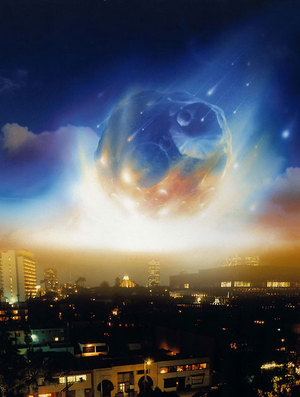 |
| ©Alamy |
The man's story turned out to be the first confirmed, eye-witness
account of the extraordinary explosion caused when a large object from
space explodes violently in the air above the ground after striking the
Earth's atmosphere. "Suddenly, in the north sky... the sky was split in
two, and high above the forest the whole northern part of the sky
appeared covered with fire," the man told the scientist. "There was a
bang in the sky and a mighty crash... The crash was followed by a noise
like stones falling from the sky, or of guns firing. The earth
trembled," he said.
The heat from the blast was so intense the man thought that his
shirt was on fire. The light from the explosion, and sunlight
subsequently reflected in the atmospheric dust, could be seen for miles
around. People as far away as London said that the night sky was so
unusually bright that it was possible to read a newspaper in their
gardens at midnight. The blast felled some 80 million trees over an
area of 800 square miles.
If the asteroid had collided just a few hours later, or had come in
on a slightly different trajectory, it could easily have exploded over
Paris, London, New York or Moscow, with devastating consequences.
Scientists calculate that if something of similar size exploded over
London today, little within the M25 would remain standing. It would be
as if a large thermonuclear bomb equivalent to 20 million tons of high
explosives had been set off in the heart of the city.
What happened at about 7am on 30 June 1908, near the Podkamennaya
Tunguska River in Siberia is now legendary among scientists studying
near-Earth objects - asteroids and comets with orbits around the Sun
that can bring them perilously close to our own planet. The Tunguska
Impact is a stark reminder that, within living memory, a large enough
object from space has hit the Earth on a latitude that could kill
millions of people.
"If you want to start a conversation with anyone in the asteroid
business, all you have to say is 'Tunguska'," says Don Yeomans, manager
of the Near-Earth Object Office at NASA's Jet Propulsion Laboratory in
Pasadena, California. "It is the only entry of a larger meteoroid we
have in the modern era with first-hand accounts."
Although the impact happened in 1908, it was not until 1921 that
Leonid Kulik, the chief curator of meteorites at St Petersburg Museum,
led the first expedition to find out what happened, and possibly
discover the crater it had left behind. He failed on that occasion
because of the harsh conditions - swampy, mosquito-infested forests in
summer and penetrating cold and ice in winter. In 1927, Kulik made
another attempt and managed to reach the blast area to witness the
devastation. He tried to get the deeply suspicious locals - reindeer
herders called the Evenki - to tell him what they remember of that
fateful morning 19 years earlier. They were reluctant, but he did
manage to speak to the man at Vanavara, about 40 miles away from the
blast's epicentre.
"At first, the locals were reluctant to tell Kulik about the event.
They believed the blast was a visitation by the god Ogdy, who had
cursed the area by smashing trees and killing animals. Those trees
acted as markers, pointing directly away from the blast's epicentre.
Later, when the team arrived at ground zero, they found the trees there
standing upright - but their limbs and bark had been stripped away.
They looked like a forest of telephone poles," says Dr Yeomans.
Kulik failed to find the impact crater, or any sign of the meteoroid
itself. But the radial pattern of the felled timber, and in particular
the central stand of trees stripped of branches, hinted at something
else - that the blast wave had come from directly overhead and radiated
out. In other words, instead of smashing into the ground, the object
had disintegrated high overhead. Such an air burst causes the branches
of trees directly below to be stripped off, leaving the trunks standing
- as they did at Hiroshima.
The absence of a crater and of meteoroid fragments has led to wild
speculation about what may have caused the explosion - from mini black
holes to space aliens. A more sensible suggestion, however, is that it
was not a space object, but an explosion caused by the sudden release
of huge quantities of methane or some other kind of explosive gas from
deep below the ground. But Dr Yeomans, along with most other experts,
dismisses this "earth-belch" idea as implausible.
"A century later, some still debate the cause and come up with
different scenarios that could have caused the explosion. But the
generally agreed-upon theory is that on the morning of 30 June 1908, a
large space rock about 120 feet across entered the atmosphere of
Siberia and then detonated in the sky," Dr Yeomans says.
Such a rock would have been travelling at about 33,500mph as it
plunged into the upper atmosphere. Friction with air molecules would
have raised the temperature of the surrounding air to something like
25,000C. At about 28,000 feet, the pressure and heat would have cause
the rock to explode into a fireball, releasing energy equivalent to
about 185 Hiroshima bombs, according to Dr Yeomans. "That is why there
is no impact crater. The great majority of the asteroid was consumed in
the explosion."
Not all scientists agree with the details of this scenario. Giuseppe
Longo of Bologna University and colleagues believe they have located a
potential crater, a large water-filled depression known as Lake Cheko,
where the meteoroid hit and was buried under permafrost. They intend to
dig for what remains of the space object to prove their case. However,
others point out that Lake Cheko lacks the attributes of a crater -
such as raised edges - and is probably nothing more than one of the
region's many oxbow lakes, formed from a river bend that collects
slow-running water that then sinks into the permafrost below.
The really big question about Tunguska is how likely it is that
something similar or worse will happen again? Asteroid experts have
calculated that something the size of the object that hit Tunguska
would strike the Earth at an average rate of one every 300 years. This
does not mean that we can expect one in 200 years' time, only that,
over a long period, they happen with a typical frequency of one every
300 years. It could happen tomorrow, or in several hundred years' time.
But as bad as a Tunguska would be over a heavily populated area,
there are far more frightening scenarios. A larger object that hits the
ground or ocean would cause more devastation by flinging debris into
the air, or causing a tsunami. These sorts of objects are estimated to
hit the Earth with a frequency of greater than once in every 1,000
years.
But their impact would be dwarfed by even bigger objects between 1km
and 10km wide. These have struck the Earth in the past with devastating
consequences. One such object is believed to have hit the Earth 65
million years ago, throwing up so much debris that it created a
"nuclear winter" that cut out sunlight for several seasons, causing the
famous mass extinction that led to the demise of the dinosaurs.
Dr Yeomans is part of a band of scientists lobbying for more
research to investigate the orbits of the near-Earth objects that could
pose a threat.With enough warning of an asteroid heading our way, it
may be possible to deflect it if it appears to be on a collision
course. Such surveys are under way. "We're identifying problems and
hope to be able to do something about it," says Dr Yeomans.
NASA hopes to identify and track 90 per cent of all hazardous
objects greater than 450 feet in diameter by the end of 2020.
Scientists say that if ever a large object is discovered on a collision
course with Earth, it might be possible to send up a nuclear-tipped
rocket to blast it off course. A safer way would be to nudge it aside
with smaller impacts, or even a "space sail" that uses the solar wind.
One of the lessons from Tunguska is that, although we are vulnerable
to the threat, it is not something that should turn us to despair -
such massive impacts are rare. As Dr Yeomans says: "I think about
Tunguska all the time from a scientific point of view, but the thought
of another Tunguska does not keep me up at night."
What are asteroids?
* Asteroids are chunks of rock or space debris left over from the
birth of the solar system. The biggest is known as Ceres, which is 567
miles wide. Comets are "dirty snowballs" composed of ice and dust -
they are less likely to hit the Earth than asteroids.
* Asteroid 2007 TU24 passed within 334,000 miles of Earth on 29
January 2008. At 800 feet wide, it was big enough to have caused global
devastation if it had hit us.
* Asteroids larger than 160 feet wide are big enough to survive the
journey through the Earth's atmosphere and hit the ground, causing
further devastation as they throw debris into the air.
* Britain and the US are taking the issue seriously. The US
Government has a near-Earth object survey Act and the UK has its own
task force on potentially hazardous near-Earth objects.
Comment: For
a more realistic idea of the probability of the Earth being struck by
comets and other objects, be sure to read the sott Comets and
Catastrophe series.
Forget the meltdown, worry about goo and asteroids
John Kay
The Financial Times
Wed, 09 Jul 2008 16:13 EDT
Last week was the 100th anniversary of
the Tunguska explosion in Siberia. If you weren't celebrating, you
should have been. The incident was probably the nearest we have come to
extinction in modern human history - and we survived.
A large object - presumably an asteroid or meteorite - collided with
the Earth. If it had landed in Manhattan, it would have destroyed New
York. A bit bigger, and it would have been calamitous wherever it
landed. A similar event at Yucatan, 65m years ago, wiped out the
dinosaurs and most other species. It would have wiped us out too had we
been there. We survived Tunguska because the impact was not too large.
There are many catastrophes graver than meltdown in the markets.
The road to oblivion has many branches and unexpected turnings.
Environmental catastrophes, like meteorites or seismic events, may do
us in. Something even more devastating than the Yucatan object is on
its way, but it may be tens of millions of years before it reaches us.
Two hundred million years before Yucatan, the Permian extinction was
even more devastating. We do not know the cause. It may have been a
meteorite, but another theory blames the "clathrate gun", a massive
release of methane from the ocean floor. Global warming could cause
large methane release from permafrost or trigger another shot from the
clathrate gun. But the environmental damage that humans cause is modest
relative to the damage the environment can impose on itself.
Many other potential apocalypses are of our own making. The
Frankenstein problem of technology run amok is beloved by science
fiction writers. The world may be taken over by man-made objects, like
robots, or mutations, like triffids. It may be submerged in grey goo
from nanotechnology. The fiction genre survives because no one can say
categorically that any of these things are impossible.
Madmen have always been a threat to humanity and technological
advance increases their capacity to do damage. Three individuals -
Hitler, Stalin and Mao - bear direct responsibility for the deaths of
30m or more people. Hitler might have destroyed the world if he had had
the means.
The influenza pandemic of 1918-19 was, with Aids, the most
devastating plague of modern times. But the Black Death killed 30 per
cent of Europe's population. Still, 70 per cent of our ancestors
survived and therefore we do also. We may not always be so lucky. A
mutant virus may wipe out humankind and leave the world to less
sociable species. The spread of the Black Death across Europe took
years, but airlines could today carry the disease everywhere within
hours.
Martin Rees, who engages with a litany of catastrophes, gave his
book the provocative title of Our Final Century? But while technology
causes many problems, it also fixes many. The Black Death was probably
bubonic plague and if so we could now cure it. Even the asteroid can be
deflected if we see it coming.
It is difficult to think about these issues in a dispassionate way. In his book Catastrophes, Richard Posner
- an American legal scholar who loves economics more than most
economists - proposes a cost/benefit analysis of all possible
disasters. But the attempts to model the end of the world are mostly
bogus. We have good data on frequencies of near-Earth objects but there
is no meaningful way to attach probabilities to these other calamities.
The best way of dealing with grave uncertainties, as with more banal
disasters, is to buy options against them. For each potential
catastrophe, we should undertake research to ascertain what we might do
if a remote possibility becomes a plausible reality. Instead, we talk
endlessly about less dangerous issues that give more scope for moral
and political posturing. Speeches about man-made environmental damage
and terrorism arouse audiences, but asteroids and grey goo elicit only
a chuckle. Our actions against more catastrophic threats are few,
ineffectual and sometimes counterproductive.
In the meantime, mark February 1 2019 and April 13 2029 in your
diaries. These are the next dates on which a very large object from
space may land on your head.
Comment: Maybe
the current financial crisis is manufactured in order to focus people's
attention on "down to Earth" matters and away from the sky, where a greater threat lurks?
New Zealand: West Coast meteor may have landed
NZPA
Thu, 10 Jul 2008 13:16 EDT
The mystery of lights spotted off the west coast of New Zealand
overnight has taken a twist with Punakaiki residents reporting a large
bang and jolt.
Christchurch police received reports from Hokitika to Nelson of a
light in the sky between 11pm and midnight, and Wanganui police
received three calls of a bright light out at sea.
Wanganui police initially thought it was a flare but then reports came in from farther afield.
There were no reports of anything hitting the ground and a meteor is suspected.
But Les Wright, a resident of Punakaiki, a coastal settlement north
of Greymouth, said he heard a rumbling sound followed by a loud thump
as if something had hit the ground at about 8pm, which is about three
hours before the lights were seen.
"There was one big jolt and then a smaller one. It was like an earthquake but not really," he said.
Prue Grant who lives on the beach at Punakaiki, also heard the noise.
"There was a huge bang, then a shake," she said.
Barrytown resident Sandy Passant saw red lights in the sky about
11pm. She also heard a noise at 8pm, and her partner Russell went
outside to investigate but could not find anything.
"It was a very strange bang. We thought it might have been an earthquake but it was different -- just a big bang."
Canterbury University Mount John Observatory superintendent Alan
Gilmore said he believed the thud was unrelated to the meteor at 11pm.
Gerry Lonie was on a fishing vessel near Hokitika and saw a meteor at 11pm.
"But there was a better one the night before -- there's been a few of them. It looked like a shooting star, it was quite a big flash but I didn't hear anything."
Constable Sean Judd, of Westport police, said he saw a light like a
"very large, close up shooting star" just before 11pm. It lasted about
three to four seconds before burning out.
"It was a white-green colour."
Asteroids and Comets: The Earth's Scars
Richard Stone
National Geographic
Tue, 15 Jul 2008 20:26 EDT
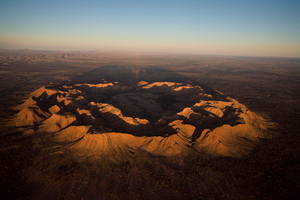 |
| ©Stephen Alvarez |
| Asteroids and comets in nearby space pose a constant threat to our planet. Can we avert catastrophe the next time around? |
The first sign of the threat was no more than a speck on a
star-streaked telescope image. Just after 9 p.m. on June 18, 2004, as
twilight faded over Kitt Peak National Observatory in Arizona, David
Tholen was scanning for asteroids in an astronomical blind spot: right
inside Earth's orbit, where the sun's glare can overwhelm telescopes.
Tholen, an astronomer from the University of Hawaii, knew that objects
lurking there could sometimes veer toward Earth. He had enlisted Roy
Tucker, an engineer and friend, and Fabrizio Bernardi, a young
colleague at Hawaii, to help. As they stared at a computer, three shots
of the same swath of sky, made a few minutes apart, cycled onto the
screen. "Here's your guy," said Tucker, pointing at a clump of white
pixels that moved from frame to frame.
Tholen reported the sighting to the International Astronomical
Union's Minor Planet Center, a clearinghouse for data on asteroids and
comets. He and Tucker hoped to take another look later that week, but
they were rained out, and then the asteroid disappeared from view.
When astronomers got a fix on it again that December, they realized
they had a problem. The rock, bigger than a sports arena, tumbles
menacingly close to our planet every few years. As observations
streamed into the Minor Planet Center, the asteroid, named Apophis
after the Egyptian god of evil, looked increasingly sinister. "The
impact hazard kept getting higher and higher," says Tholen. By
Christmas, models predicted 1-in-40 odds that Apophis would smash into
Earth on April 13, 2029, and a ripple of alarm spread to the public.
"One colleague called it the grinch that stole Christmas," Tholen says.
Then on December 26, 2004, a real catastrophe struck: the Indian
Ocean tsunami, which claimed hundreds of thousands of lives. The public
forgot about Apophis. In the meantime, astronomers had dug out earlier
images of the asteroid. The extra data enabled the scientists to
calculate its orbit, and they discovered that it would actually whiz
safely by Earth in 2029. But they could not rule out a slender chance
that Apophis would strike with catastrophic effect its next time
around, on Easter Sunday, 2036.
An estimated ten million rocky asteroids and ice-and-dirt comets
pirouette in outer space, and once in a while their paths fatefully
intersect our planet's. One such encounter took place a
hundred miles from present-day Washington, D.C., where a 53-mile-wide
crater lies buried beneath Chesapeake Bay - the scar left when a
two-mile-wide rock smashed into the seafloor 35 million years ago. More
notorious is the titan, six miles in diameter, that barreled into the
Gulf of Mexico around 65 million years ago, releasing thousands of
times more energy than all the nuclear weapons on the planet combined.
"The whole Earth burned that day," says Ed Lu, a physicist and former
astronaut. Three-quarters of all life-forms, including the dinosaurs,
went extinct.
Astronomers have identified several hundred asteroids big enough to
cause a planetwide disaster. None is on course to do so in our
lifetimes. But the heavens teem with smaller, far more
numerous asteroids that could strike in the near future, with
devastating effects. On June 30, 1908, an object the size of a 15-story
building fell in a remote part of Siberia called Tunguska. The
object - an asteroid or a small comet - exploded a few miles before
impact, scorching and blowing down trees across 800 square miles. The
night sky was so bright with dust from the explosion, or icy clouds
from the water vapor it blasted into the upper atmosphere, that for
days people in Europe could read newspapers outdoors at night. On Tunguska's hundredth anniversary, it's unsettling to note that objects this size crash into Earth every few centuries or so.
The next time the sky falls, we may be taken by surprise. The vast
majority of these smallish bodies, capable of wiping a city off the
map, are not yet on our radar screens. "Ignorance is bliss, in that if
you don't know about these things, you just go about your merry way,"
says Lu. Over the next decade, however, sky surveys like Tholen's
should begin filling that gap, cataloging asteroids by the thousands.
"Every couple of weeks," says Lu, "we're going to be finding another
asteroid with like a one-in-a-thousand chance of hitting the Earth."
The goal is not just to foretell the date and time of a potential
catastrophe. The goal is to forestall it. With years or decades of
warning, a spacecraft, using its own minuscule gravity, might nudge a
threatening asteroid off course. For objects requiring a bigger kick, a
kamikaze spacecraft or a nuclear bomb might do the job. Vexing dilemmas
would attend this showdown in space. How will governments decide to
act? "This is a class of problem that the world isn't set up to deal
with," says physicist David Dearborn, an advocate of a nuclear strike
against an incoming asteroid.
Two facts are clear: Whether in 10 years or 500, a day of reckoning is inevitable. More heartening, for the first time ever we have the means to prevent a natural disaster of epic proportions.
Every day, dozens of tons of detritus from outer space - dust from
comets, tiny shards of asteroids - burn up in the Earth's upper
atmosphere, leaving bright meteor trails at night. Most days a chunk or
two of rock or metal, fist size or bigger, survives the fiery plunge.
Yet the odds of seeing a meteorite hit the ground, let alone being
struck, are phenomenally low. Only one is known to have hit a person.
Around 1 p.m. on November 30, 1954, a meteorite tore through the roof
of a house near Sylacauga, Alabama, across the street from the Comet
Drive-in Theatre. The rock, about the size of a softball, caromed off a
console radio and clipped Ann Hodges as she snoozed on her couch,
bruising her left hip and wrist. She was hospitalized to recover from
the shock.
Since then, there have been some spectacular near misses. On August
10, 1972, an object around 15 feet across and weighing 150 tons skipped
off the upper atmosphere. Hundreds of eyewitnesses saw the glowing
streak, dazzling on a sunny afternoon, as it traversed the sky from
Utah to Alberta before whizzing back out into space. On March 22, 1989,
a rock as much as a thousand feet across came within a few hundred
thousand miles of Earth - an uncomfortably close shave.
Erosion and vegetation have erased most of the scars left by impacts
in the geologic past. Perhaps the best preserved lies about half an
hour east of Flagstaff, Arizona. On a late autumn morning Carolyn
Shoemaker and I pull off Interstate 40 and wind through scrubby desert
toward a low rise marking the rim of the crater. Fifty thousand years
ago this was a forested plain inhabited by mammoths, giant ground
sloths, and other Ice Age animals. Shoemaker, an asteroid expert with
the Lowell Observatory in Flagstaff, imagines the day the sky fell.
"Suddenly, there's a terrific, brilliant light," she says. In a flash,
a searing-hot iron-nickel mass, 150 feet wide and weighing 300,000
tons, tears into the Coconino sandstone, flinging boulders and molten
iron for miles. A blast of wind more powerful than any earthly tornado
scours the landscape.
All that's left of the cataclysm now is a chasm three-fourths of a
mile wide and 570 feet deep, fringed with Mormon tea bushes. At the
turn of the 20th century, an engineer named Daniel Moreau Barringer was
convinced that a massive iron meteorite lay beneath the crater and
obtained the mining rights to the land. But after a series of shafts
revealed nothing, many prominent geologists concluded that a volcanic
eruption, not a meteorite, had formed the crater.
Carolyn's husband, Gene, made Meteor Crater one of America's most
recognizable landmarks. In the late 1950s he mapped the overturned rock
around the crater and pointed out similarities to the Teapot Ess crater
in Nevada, formed by a nuclear test. His data showed that Barringer was
right: A meteorite had gouged the crater, although most of the iron had
melted into tiny droplets. Several of Barringer's shafts can still be
seen from the rim, along with a full-size cutout of a waving astronaut
- a nod to NASA, which once used the crater as a training ground. Some
visitors whisper and point at Carolyn, and one man plucks up the
courage to come over and request her autograph. Carolyn is famous in
her own right. She discovered a comet that, in 1994, vividly
demonstrated the cosmic threat we face.
In 1980, their children grown and out the door, Gene suggested that
Carolyn start a career as an asteroid hunter. "I'm a morning person,"
she says. "I had never stayed awake all night in my life. I didn't know
if I could do that." But she decided to give asteroid hunting a shot.
Gene had access to the Palomar Observatory near San Diego. "After a
couple years, I learned how to discover things," she says, modestly.
She has 32 comets and 367 asteroids to her credit. "Some are more
interesting than others."
On March 25, 1993, Carolyn, Gene, and David Levy, an amateur
astronomer, were at Palomar for their scheduled observation time. Snow
was falling, and the night promised to be long and boring. Carolyn
killed time by studying a batch of overexposed film from the previous
night. Many frames were worthless. On one of the last images, however,
she came across a smudge. "I said, 'It looks like a squashed comet.' "
The team asked astronomers at Kitt Peak to take a look. It then
occurred to Carolyn that her squashed comet might be a broken comet.
Confirmation came that same night when Kitt Peak spotted a string of
comet shards traveling together.
Other astronomers soon counted some two dozen pieces of comet
Shoemaker-Levy 9 and worked out its strange history and fate. In July
1992, it seemed, the comet had swung so close to Jupiter that the
giant's massive gravity had torn it apart. Now the remnants, some of
them hundreds of feet wide, were destined to collide with Jupiter in
July 1994. When the time came, most of the world's astronomers were
watching.
The impacts took place on Jupiter's far side, out of sight of Earth,
but the blows sent superheated gas billowing far above the atmosphere.
The largest unleashed shock waves that roiled an area at least three
times the width of Earth. "It was pretty awesome," Carolyn says. The
Shoemakers basked in the glow of their discovery. Then tragedy struck.
In 1997 they were in a head-on car crash in the Australian outback.
Gene died at the scene. An ounce of his ashes traveled to the moon with
NASA's Lunar Prospector spacecraft.
Carolyn scattered the rest at Meteor Crater.
If the Shoemakers' namesake or the monster that annihilated the
dinosaurs were bearing down on us, there would be little we could do.
For every planet killer, however, there are thousands of smaller
asteroids and comets - up to a mile or so across - that could
conceivably be deflected. First we'd have to see them coming.
In 1998 the U.S. Congress ordered NASA to identify at least
90 percent of the largest asteroids and comets in the inner solar system
- objects six-tenths of a mile or more in diameter. To date, telescopes
have pinpointed more than 700 out of an estimated population of 1,000. In
2005 Congress got more ambitious, directing the space agency to track
down the far more numerous asteroids 460 feet or more in diameter - still big enough to take out a city or state.
A new telescope is about to begin scanning the sky for these dim,
elusive objects. From a peak on Maui, the Panoramic Survey Telescope
and Rapid Response System, or Pan-STARRS, will scrutinize the night sky
with a 1.4-billion-pixel camera that produces images so detailed a
single one, if printed, would cover half a basketball court. Computers
will scan the data, flagging statistical curiosities that astronomers
can check the old-fashioned way, by taking a look. The Maui telescope
is just a prototype; ultimately, Pan-STARRS will include an array of
four cameras. "We'll have catalogs of all the things that go bump in
the night," says Ken Chambers of the University of Hawaii, including
perhaps 10,000 potentially hazardous asteroids.
Within decades, the world's leaders may be forced to grapple with a
momentous decision: whether and how to deflect an incoming object. Few
experts are giving this much thought, says astronomer David Morrison of
NASA's Ames Research Center: "The number would roughly staff a couple
shifts at a McDonald's."
Lu, the former astronaut, is one. Now an executive at Google,
he is helping design a massive database for a successor to Pan-STARRS,
the Large Synoptic Survey Telescope, which will scrutinize the sky in
even more detail starting in 2014. Lu is also the coauthor of a scheme
for using a spacecraft to coax an earthbound asteroid off its dangerous
path. "We were originally thinking about how you would land on an
asteroid and push it," he says. "But that doesn't work well." If the
surface is crumbly, the lander might skid off. Moreover, asteroids
twirl through space. "If you're pushing and the thing is rotating, the
pushing just cancels out," Lu says.
Then he and Stanley Love, a fellow astronaut, realized pulling would
be much easier. A spacecraft could hover nearby and fire its thrusters,
gently tugging the asteroid along. No harpooning or lassoing would be
required. "Rather than having a physical line between you and the thing
you're towing, you're just using the force of gravity between them," Lu
says. The "gravity tractor" would tug the asteroid off course at a mere
fraction of a mile an hour. But this subtle shift, magnified over the
vastness of space, could mean missing Earth by tens of thousands of
miles.
Lu's scheme would work only for asteroids up to a few hundred yards
across that could be engaged far from Earth. If a small rock sneaks up
on us, we could try ramming it with a spacecraft. But there's a
drawback, says Morrison: "If you hit an asteroid with enough energy to
break it apart, but not necessarily enough energy to disperse it
widely, you now have a flying collection of stuff. You have to ask how
practical that is." When all else fails, and for large asteroids and
comets, only one strategy has a chance of working: We'll have to bomb
them back to the Stone Age.
Stands of frosted firs and white birch cluster along the highway
leading southwest from Yekaterinburg, the city in the Ural Mountains
where Russia's last tsar, Nicholas II, and his family were murdered 90
years ago. Under a dull sun, fishermen huddle over holes on a frozen
lake, floppy-eared fur hats hiding their faces. A road with a
misspelled signpost for a tiny village marks the turnoff for the
formerly secret city of Snezhinsk, code-named Chelyabinsk-70 during the
Cold War. Snezhinsk is home to one of Russia's two main nuclear weapons
laboratories. After the collapse of the Soviet Union, it fell on hard
times; ten years ago, with Russia's economy in shambles, staff salaries
went unpaid, and the director committed suicide.
Nowadays, with Russia prospering, the laboratory is humming with top
secret work. Obtaining permission to enter proved impossible. But Vadim
Simonenko, the deputy scientific director, and experimentalist Nikolay
Voloshin agreed to meet at a sanatorium in nearby Dalnyaya Dacha. In a
cool, dim, and empty dining hall, Voloshin opens a bottle of cognac,
and over salmon canapés, cold cuts, and sliced cucumbers, the two
weapons scientists discuss how their bombs could save the world.
If Edward Teller is the father of the hydrogen bomb, Simonenko is
the father of the asteroid bomb. In the mid-1960s the superpowers
dreamed of using their nuclear arsenals for peaceful purposes, such as
leveling mountains and digging canals. Simonenko, a new recruit to the
lab, was asked to study the effects of a torpedo-shaped charge that
would explode laterally, ideal for earthmoving. It occurred to him that
such a device could also be used to deflect an object in space. He told
his boss, who laughed and ordered the eager young physicist to get back
to work.
Though nuclear excavation never became a reality, Simonenko went on
studying nuclear asteroid deflection. He and Voloshin concluded that
the best way to deflect an asteroid up to a mile or so wide would be to
detonate a nuclear charge nearby. The intense radiation would fry the
surface, driving off a "sacrificial layer" of rock. The expanding vapor
would act as a rocket motor, nudging the asteroid onto a new
trajectory. For a smaller, Tunguska-size rock, Simonenko says, "it
would be simpler: We vaporize it."
Simonenko has a brother-in-arms in nuclear physicist David Dearborn
of Lawrence Livermore National Laboratory in northern California.
Dearborn's day job is determining whether the aging weapons in the U.S.
nuclear stockpile are reliable. In his spare time, he ponders asteroid
defense. He, too, favors a standoff nuclear blast. "Not too close -
then the blast is too intense, and things shatter too much. And not too
far, or you don't get enough energy."
Although it may be technically straightforward to dust off a few
warheads and sling them at an asteroid, deciding whether to press the
red button - and which nation gets to press it - could be excruciating.
First, the nation with its finger on the trigger would have to withdraw
from the Outer Space Treaty, which bans the use of nuclear weapons in
space. But if catastrophe looms, says Dearborn, "people would really
have to say, 'Can we be brighter than the dinosaurs?'"
Apophis may pose the first real test of our collective intelligence.
For now, scientists can give only a range of probabilities for its
future trajectory. As it swings past Earth in 2029, ducking under
dozens of high-flying communications and spy satellites and appearing
as a bright star lumbering across the night skies over Europe, there's
a slim chance that Apophis will pass through a "keyhole." In this
narrow corridor of space, maybe a few hundred yards wide, Earth's
gravity would deflect the asteroid just enough to put it on a certain
collision course with our planet on the next pass, in 2036. The odds
that Apophis will pass through this fatal corridor are currently
estimated at 1 in 45,000. Continued tracking will almost certainly
deliver an all clear a few years from now. If not, we might have to
wait until weeks after its close approach in 2029 to learn whether
Apophis has squeezed through a keyhole, leaving us precious little time
to avert calamity in 2036.
In the prophesies of the Hopi of the American Southwest, the arrival
of a spirit called Yellow Star Kachina will herald the end of the
world. When Hopi elders heard about Apophis in 2004, they worried that
Yellow Star Kachina was on its way. Carolyn Shoemaker tried to reassure
them that it was not.
Let's hope she was right.
Comment: The threat to Earth by asteroids and comet fragments has been increasing dramatically, please see our 'must-read' Comet Series for more information.
Chile: Meteorite trail surprises Punta Arenas and Tierra del Fuego
Merco Press
Fri, 18 Jul 2008 15:36 EDT
It is almost confirmed that the bright flash seen last Monday
night in great parts of Magallaes region, included Tierra del Fuego in
the extreme south of Chile was a meteorite.
Residents throughout the region: in Punta Arenas, Puerto Natales and
in Tierra del Fuego Porvenir recall seeing at approximately 10:30 p.m.
a bright flash in the night sky. Witnesses then heard a loud crack,
presumably the result of the meteorite breaking the sound barrier as it
passed over the region, reported the local press.
The head of the Punta Arenas Airport, Jan Carlo Onetto, confirmed that the unidentified flying object was not of human origin.
"In the four years I've lived in the area, the radars have never
before detected something that wasn't a plane," he said. "I think it
was a meteorite that entered the zone at high speed and broke the sound
barrier, thus producing the loud crack. People are assuming it fell
somewhere south of here. It may have fallen in the Straights (of
Magellan) or further south."
Onetto's theory was corroborated by Chilean Antarctic Institute
scientist Stefan Kraus, who told Radio Polar that the object was likely
a "stony" meteorite, the most common type. "All the data collected and
the observations so far, confirm it", he added.
"The fire ball, the stellar trail and the loud sound which was
reported are typical of this kind of phenomenon in any part of the
world; so we can say it was a meteorite", said Krauss who nevertheless
pointed out it would very difficult to trace any tiny rests on the soil
and if so, "it would be extremely lucky".
"Tiny pieces must have spread over miles of open range, many
kilometers from Punta Arenas and in unpopulated areas of Patagonia",
said Krauss.
10 Greatest Major-Impact Craters on Earth (photo)
Environmental Graffiti
Fri, 18 Jul 2008 17:03 EDT
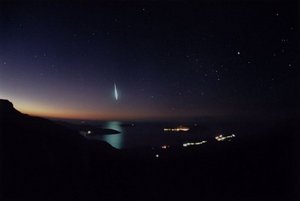 |
| ©Unknown |
Imagine staring into the sky and seeing a tiny yellow dot, gradually
getting closer. That dot doubles in size every second, until it slowly
darkens the sky. You realize that this dot is actually the size of New
York City and is screeching through the atmosphere faster than the
speed of sound, coming right for you. This massive object will cause
tsunamis, earthquakes and obliterate natural daylight for years...oh...
and it will kill you. Similar asteroid impacts have and will happen on
numerous occasions in our earth's history. Today we'll show you the
biggest impact craters by diameter.
10. Barringer Crater, Arizona, US
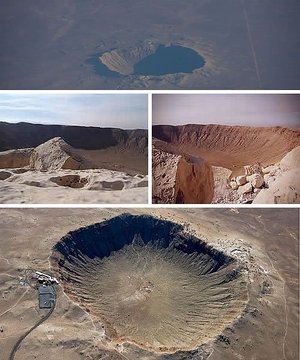 |
| ©Unknown |
Some 49,000 years ago a large nickel-iron meteorite "just" 150 ft
across, weighing several hundred thousand tons (~300,000) and traveling
at a speed of 40,000 miles per hour, hit Earth. The result of this
meteor lies 55 km east of Flagstaff, Arizona and is called the
Barringer Crater: the best preserved impact crater ever. The force
generated by the impact was equal to the explosion of 20 million tons
of TNT. Picture that.
It measures 0.75 miles (1.2 km) across, is 575 ft (175 m) deep and
has a rim 148 ft (45 m) higher than the surrounding plain. Discovered
in 1902, the Barringer Crater was named after Daniel Barringer, a
successful mining engineer. Today it is still owned by his family and
is also known as Meteor Crater, Coon Butte, and Canyon Diablo.
9. Bosumtwi, Ghana
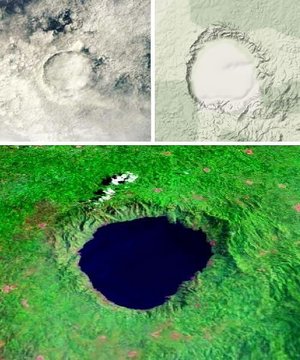 |
| ©Unknown |
About 30 km south-east of Kumasi, Ghana, in the crystalline bedrock
of the West African Shield, lies Lake Bosumtwi: the country's only
natural lake. The impact of a meteorite some 1.3 million years ago,
opened up hole in the ground with a 6 mile (10.5 km) diameter. The
crater gradually got filled with water to form the lake we see today.
Surrounded by dense rainforest, the Ashanti people consider it to be
sacred. They think it's the place where souls of the dead come to bid
farewell to the god Twi.
8. Deep Bay, Canada
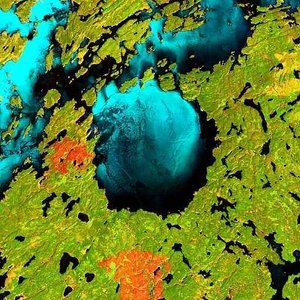 |
| ©Ersi |
Situated near the south-western tip of Reindeer Lake in
Saskatchewan, Canada, Deep Bay is a strikingly circular, very deep and
unusually irregular and shallow lake. The 8 mile (13km) wide crater is
a complex impact structure with a low, totally submerged central
uplift, formed about 100 million years ago (some say 140 million) when
a large meteorite crashed in the area.
7. Aorounga impact crater, Chad
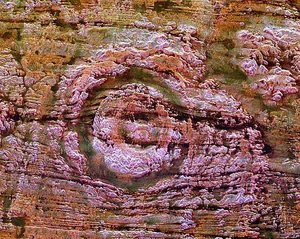 |
| ©Unknown |
Aorounga is an eroded meteorite impact crater that formed 2-300
million years ago in an area of the Sahara Desert, northern Chad, in
Africa, when a comet or asteroid with a 1 mile diameter (1.6 km across)
hit the crust of Earth. Such impacts only happen roughly, once every
million years.
The crater is about 11 miles (17 km) across and is accompanied by
two nearby circular features that have been revealed by the Space
Shuttle's SIR-C radar after picturing an area of about 22 miles (36
km). If the assumptions and the hypothesis that the dark band in the
upper right corner could be a second impact crater, then Aorounga may
be part of a chain of multiple impact craters.
6. Gosses Bluff, Australia
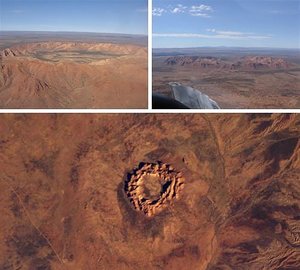 |
| ©Unknown |
Approximately 142 million years ago, a large asteroid or comet (22
km in diameter) crashed at 40 km/sec in the southern Northern
Territory, near the center of Australia, and released massive energy
equivalent to 22 000 megatonnes of TNT. This is how one of the most
significant impact structures in the world, the Gosses Bluff crater
formed. Dimensions are also impressive: it has a 15 mile (24km)
diameter and goes down to 16,400 ft (5,000m). What we get to see today
is a highly eroded structure that still stands as a stark reminder of
the event.
5. Mistastin Lake, Canada
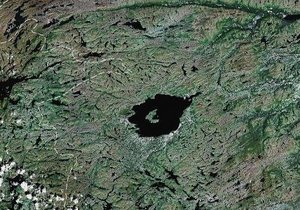 |
| ©Unknown |
Located in Labrador, Canada, the Mistastin crater is the result of a
meteorite crash, that caused a 17.4 miles (28km) wide giant hole into
the ground, 38 million years ago. Since then the eastward moving
glaciers have drastically reduced its size and a lake appeared within
the rims, Mistastin Lake. It occupies an elliptical, east - north-east
trending depression, approximately 11 by 7 miles in size. In the middle
of the lake, there's an arcuate central island which could be the
central uplift of the complex crater structure.
4. Clearwater lakes, Canada
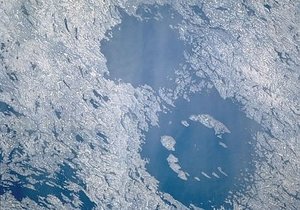 |
| ©Unknown |
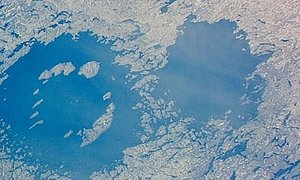 |
| ©Unknown |
Two circular lakes/impact craters on the Canadian Shield in Quebec
formed simultaneously by the impact of an asteroid pair which crashed
on Earth approximately 290 million years ago, near the eastern shore of
Hudson Bay. The larger of the two craters is West Clearwater Lake with
a 20 mile (32km) diameter while the smaller one, East Clearwater Lake
has a 13.7 mile (22km) diameter. The lakes are a great tourist location
mostly because of the number of sprinkling islands that form a sort of
a "dotted line". The lakes are also, obviously, famous for their clear
waters.
3. Kara-Kul, Tajikistan
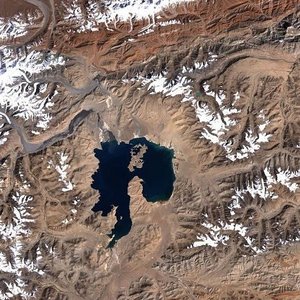 |
| ©Unknown |
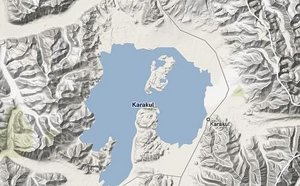 |
| ©Unknown |
At an altitude of 13,000 feet (3,900 m) above sea level, lies
Kara-Kul, also known as Qarokul: a 16 mile (25km) wide lake in the
Pamir Mountains in Tajikistan, close to the Chinese border. The lake is
actually located within a 28 mile (45km) wide circular depression,
which was hit by a meteorite approximately 5 million years ago,
Kara-kul was only discovered recently, through satellite imagery.
2. Manicouagan, Canada
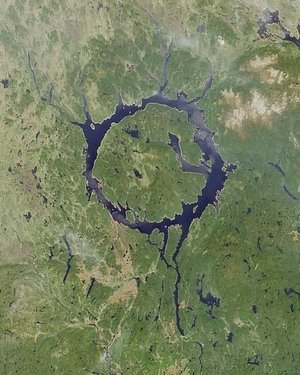 |
| ©Unknown |
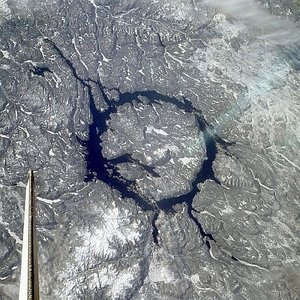 |
| ©Unknown |
Manicouagan Reservoir (Lake Manicouagan) also known as the "eye of
Quebec", is an annular lake in central Quebec, Canada, that lies within
the remains of an ancient, eroded impact crater. Some 212 million years
ago, a 3 mile (5km) wide asteroid hit the earth, to causing a 62 mile
(100km) wide giant hole. It has been worn away by the passing of
glaciers and other erosive processes, ever since.
1. Chicxulub, Mexico
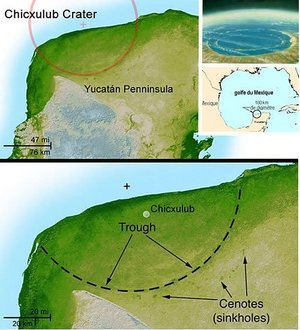 |
| ©Unknown |
Buried underneath the Yucatán Peninsula in Mexico, near the
Chicxulub village (which means "the tail of the devil" in Mayan), this
ancient impact crater is simply huge at 105 miles (170km) in diameter.
The impact happened roughly 65 million years ago when a comet or
asteroid the size of a small city crashed (equivalent to 100 teratons
of TNT) on Earth and caused destructive mega-tsunamis, earthquakes and
volcanic eruptions around the globe.
The Chicxulub impact is widely believed to have led to the
extinction of dinosaurs, because of a global firestorm or because of a
dramatic and widespread greenhouse effect that caused long-term
environmental changes.
Lack of cracks may explain Peru meteorite mystery
Devin Powell
ScientistSpace
Thu, 03 Jul 2008 14:33 EDT
It's the Superman of space rocks. A mysterious meteorite that crashed to Earth last year may have been the toughest of its kind.
The Carancas meteorite
struck the town of that name in Peru last September, blowing a hole in
the ground 13 metres wide. The fact that locals saw a single object
strike suggests a meteorite made of iron, like the one that created a
similar crater in 1990 in Sterlitamak, Russia, because stony meteorites
normally fragment high above the Earth and spread relatively harmlessly
over a wide area. However, the debris found by investigators was stone.
One explanation for this conundrum, though at odds with the eyewitness accounts, is that the object broke into smaller pieces
which hit the ground together. Another theory is that the meteorite was
one of many chunks from a larger, slow-moving object which broke up
when it met the atmosphere at a glancing angle. Yet all these chunks
would probably have been travelling too slowly to create the Carancas
crater.
Now Pavel Spurný and colleagues at the Astronomical Institute of the
Academy of Sciences of the Czech Republic argue that the object could
have survived the descent intact if, by a one-in-a-million chance, it
lacked internal cracks and irregularities. Using estimates from other
groups of the meteorite's trajectory, velocity and impact energy,
Spurný and colleagues built a computer model showing that an object
around 1 metre across could enter the atmosphere at a relatively fast
20 kilometres per second and survive the descent if it was free of
cracks (Astronomy & Astrophysics, vol 485, p L1).
Jay Melosh, a geophysicist at the University of Arizona in Tucson,
doubts Spurný's theory. He says stone fragments found at the scene are
so soft that they crumble to the touch, so the object was probably made
of rock held together by iron - which is yet to be found.
Comets and Asteroids - Learn more about the threat to human civilisation in our special report.
Tunguska catastrophe: Evidence of acid rain supports meteorite theory
Science Centric
Sat, 19 Jul 2008 18:17 EDT
The Tunguska catastrophe in 1908 evidently led to high levels of
acid rain. This is the conclusion reached by Russian, Italian and
German researchers based on the results of analyses of peat profiles
taken from the disaster region.
In peat samples corresponded to 1908 permafrost boundary they found
significantly higher levels of the heavy nitrogen and carbon isotopes
15N and 13C. The highest accumulation levels were measured in the areas
at the epicentre of the explosion and along the trajectory of the
cosmic body. Increased concentrations of iridium and nitrogen in the
relevant peat layers support the theory that the isotope effects
discovered are a consequence of the Tunguska catastrophe and are partly
of cosmic origin. It is estimated that around 200,000 tons of nitrogen
rained down on the Tunguska region in Siberia at that time. 'Extremely
high temperatures occurred as the meteorite entered the atmosphere,
during which the oxygen in the atmosphere reacted with nitrogen causing
a build up of nitrogen oxides,' Natalia Kolesnikova told the Russian
news agency RIA Novosti on last Monday. Mrs. Kolesnolova is one of the
authors of a study by Lomonosov Moscow State University, the University
of Bologna and the Helmholtz Centre for Environmental Research (UFZ),
which was published in the journal Icarus in 2003.
The Tunguska event is regarded as one of the biggest natural
disasters of modern times. On 30 June 1908 one or more explosions took
place in the area close to the Tunguska River north of Lake Baikal. The
explosion(s) flattened around 80 million trees over an area of more
than 2000 square kilometres. The strength of the explosion is estimated
to have been equivalent to between five and 30 megatons of TNT. That is
more than a thousand times as powerful as the Hiroshima bomb. This
almost unpopulated region of Siberia was first studied in 1927 by
Professor Leonid A. Kulik. There are a number of different theories
about what caused the catastrophe. However, the majority of scientists
assume that it was caused by a cosmic event, such as the impact of a
meteorite, asteroid or comet. If it had exploded in the
atmosphere just under five hours later, St. Petersburg, which was the
capital of Russia at that time, would have been completely destroyed
because of the Earth's rotation.
In two expeditions in 1998 and 1999, Russian and Italian researchers
took peat profiles from various locations within the Siberian disaster
area. The type of moss studied, Sphagnum fuscum, is very
common in the peat material and obtains its mineral nutrients
exclusively from atmospheric aerosols, which means that it can store
terrestrial and extraterrestrial dust. Afterwards, the samples were
analysed in laboratories at the University of Bologna and the Helmholtz
Centre for Environmental Research (UFZ) in Halle/Saale. Among other
things, the UFZ specialises in isotope analyses of sediments, plants,
soil and water and it was asked to help by the team of Moscow
researchers led by Dr Evgeniy M. Kolesnikov. Kolesnikov, who has been
investigating the Tunguska event for 20 years, has been to Leipzig
University and UFZ twice as a guest researcher with the help of the
German Research Foundation (DFG) to consult with the isotope experts.
'The levels of accumulation of the heavy carbon isotope 13C measured
right on the 1908 permafrost boundary in several peat profiles from the
disaster area cannot be explained by any terrestrial process. This
suggests that the Tunguska catastrophe had a cosmic explanation and
that we have found evidence of this material,' explains Dr Tatjana
Boettger of the UFZ. Possible causes would be a C-type asteroid like
253 Mathilde, or a comet like Borelly.
Source: Helmholtz Association of German Research Centres
Strange object filmed in skies above Winnipeg
CTV News Staff
CTV.ca
Tue, 22 Jul 2008 20:59 EDT
Is it a comet, an aircraft, or satellite debris burning up in the
atmosphere? A Winnipeg woman is asking for help to explain a mysterious
object she caught on camera.
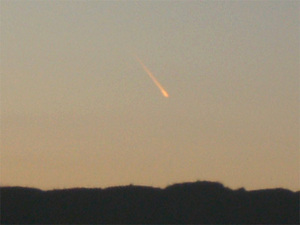 |
| ©MyNews.CTV.ca / Sylvia McLeod |
| Image of a strange object seen in the sky over Winnipeg, Man. on Monday, July 21, 2008 |
"It was like a red fireball falling down from the sky," Sylvia McLeod, 31, told CTV.ca Tuesday.
"I have no idea what it is. I thought it would be all over the news. I went on the Internet and tried to find any information, but couldn't find anything."
McLeod said she filmed the strange object Monday night between 9:30 p.m. and 10:30 p.m., just as the sun set.
"It was moving kind of slowly. But I knew it was falling. I couldn't
get the whole shot of it because my camera didn't have enough memory,"
she said.
Asked whether she had ever seen anything like it before, McLeod answered: "Only in movies."
Prof. Jaymie Matthews, of the Department of Physics and Astronomy at
the University of British Columbia, said he wasn't sure exactly what
was caught on camera -- but he ruled out several possibilities.
"A comet that bright, that close to the Sun, visible in the twilight
sky, would have been spotted by professional and amateur astronomers
long before last night," he wrote in an email from Paris. "And it would
have been visible to people across North America last night, and still
tonight."
He added that it was also definitely not a meteor, fireball or
disintegrating space debris. "It would have moved across the sky or
even below the horizon in the time covered by the video footage," he
wrote.
Comment: Since there is no copy of the video
available at this time to determine how fast it was moving, one cannot
"definitely" rule out that is was not a meteor, fireball or
disintegrating space debris either.
So what was it?
Chris Rutkowski, who has seen hundreds of strange unexplained images
as director of the Winnipeg-based Ufology Research Institute, said his
best guess would be a plane.
He said it would be "high enough that it's still in sunlight as the
sun was setting," and the tail of the object would be the contrail of
the aircraft -- the vapour trail left by the plane's engines.
The 2008 Perseid Meteor Shower
Physorg.com
Wed, 23 Jul 2008 03:49 EDT
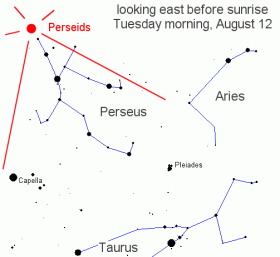 |
| ©Unknown |
"The time to look is during the dark hours before dawn on Tuesday,
August 12th," says Bill Cooke of NASA's Meteoroid Environment Office at
the Marshall Space Flight Center. "There should be plenty of
meteors--perhaps one or two every minute."
The source of the shower is Comet Swift-Tuttle. Although the comet
is far away, currently located beyond the orbit of Uranus, a trail of
debris from the comet stretches all the way back to Earth. Crossing the
trail in August, Earth will be pelted by specks of comet dust hitting
the atmosphere at 132,000 mph. At that speed, even a flimsy speck of
dust makes a vivid streak of light when it disintegrates--a meteor!
Because, Swift-Tuttle's meteors streak out of the constellation
Perseus, they are called "Perseids."
Serious meteor hunters will begin their watch early, on Monday
evening, August 11th, around 9 pm when Perseus first rises in the
northeast. This is the time to look for Perseid Earthgrazers--meteors
that approach from the horizon and skim the atmosphere overhead like a
stone skipping across the surface of a pond.
"Earthgrazers are long, slow and colorful; they are among the most
beautiful of meteors," says Cooke. He cautions that an hour of watching
may net only a few of these at most, but seeing even one can make the
whole night worthwhile.
A warm summer night. Bright meteors skipping overhead. And the peak is yet to come. What could be better?
The answer lies halfway up the southern sky: Jupiter and the gibbous
Moon converge on August 11th and 12th for a close encounter in the
constellation Sagittarius: sky map. It's a grand sight visible even
from light-polluted cities.
For a while the beautiful Moon will interfere with the Perseids,
lunar glare wiping out all but the brightest meteors. Yin-yang. The
situation reverses itself at 2 am on Tuesday morning, August 12th, when
the Moon sets and leaves behind a dark sky for the Perseids. The shower
will surge into the darkness, peppering the sky with dozens and perhaps
hundreds of meteors until dawn.
For maximum effect, "get away from city lights," Cooke advises. The
brightest Perseids can be seen from cities, he allows, but the greater
flurry of faint, delicate meteors is visible only from the countryside.
(Scouts, this is a good time to go camping.)
The Perseids are coming. Enjoy the show!
Small Satellite Designed to Spot Big Bad Asteroids
Jeremy Hsu
Space.com
Wed, 23 Jul 2008 18:43 EDT
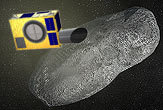 |
| ©Unknown |
A tiny Canadian satellite is gearing up for a mission to hunt wayward space rocks that may pose a threat to Earth.
Only the size of a suitcase, the Near Earth Object Surveillance
Satellite (NEOSSat) has a 5.9-inch (15-cm) telescope and weighs about
143 pounds (65 kg). But it's designed to hunt for threatening space
rocks from Earth orbit, where the telescope can avoid interference from
the planet's atmosphere.
"That's why a small telescope in space can be a lot more comparable
to a large telescope on the ground," said Alan Hildebrand, planetary
scientist at the University of Calgary and head of the asteroid search
project for NEOSSat.
The Canadian microsatellite would also keep an eye on Earth's
satellite traffic for both U.S. and Canadian space commands, swiveling
around to target space rocks and satellites hundreds of times a day.
That requires a revolutionary turning system for the $12
million-satellite to do its job upon launch in early 2010.
Astronomers have particular interest in Near Earth Objects, because
such objects might threaten Earth in the near or distant future. Nearby
asteroids could likewise serve as targets for future spacecraft
missions to investigate.
NEOSSat will also shed more light on the less famous Inner Earth
Objects, or asteroids found close to the sun within Earth's orbit,
mission managers said.
Point and click
NEOSSat draws upon the technological heritage of a star-gazing
mission called MOST (Microvariability and Oscillation of STars), which
represented Canada's first space telescope. But the newer
microsatellite also boasts an attitude control system based on spinning
reaction wheels that allow it to turn quickly without consuming rocket
fuel.
"We have to be able to point precisely at a chunk of sky for 100
seconds," Hildebrand told SPACE.com. "Then you want to be able to slew
from one field to another as fast as possible."
Such rapid response balances out with the need to keep the space
telescope steady on its target, whether peering at rocks in the
asteroid belt or tracking a moving satellite.
"The attitude-control system is an absolute must," said Brad
Wallace, scientist at Defense Research Development Canada (DRDC), the
agency working with the Canadian Space Agency on NEOSSat.
However, the system's reaction wheels don't require consumable fuel
to do their work. NEOSSat will draw power from solar panels that
convert the sun's energy into the required amount of electricity - just
45 watts, or less power than an average light bulb.
Let's go asteroid hunting
Low energy usage and a small size may make NEOSSat seem paltry
compared to large ground telescopes that can cost $50 million and up.
But scientists look forward to having a space telescope that can check
out asteroids without bad weather or atmospheric background getting in
the way.
"In terms of advantages of being in space, we've got 24/7 availability," Hildebrand said.
Ground telescopes face limits even with blue skies on Earth, because
the atmosphere makes it harder to spot the faint light signals from
asteroids. NEOSSat reduces the background interference to one tenth of
that on Earth, by going up roughly 435 miles (700 km) above the
atmosphere.
Hildebrand hopes the microsatellite to discover at least 100 Near
Earth Objects per year once operational, and many more asteroids in the
main asteroid belt between Mars and Jupiter.
Space traffic control
The microsatellite will also spend half its time tracking other satellites in orbit around Earth.
"Our first and foremost goal is to demonstrate satellite tracking
capability," said Wallace, who leads the DRDC science team focused on
traffic control.
Wallace's team will spend NEOSSat's first year testing new observing
and tracking techniques, before handing over the keys to DRDC's client,
the Canadian Forces. That would allow the space telescope to take a
more active role in helping the North American Aerospace Defense
Command (NORAD) monitor the skies.
Satellite tracking requires slightly less of the microsatellite's
capabilities, but Wallace also plans to test it on scenarios such as
tracking "lost" objects and doing hand-off coverage that picks up from
where another telescope began.
NEOSSat's ability to take on dual responsibilities points to a
future where microsatellites increasingly become the standard. The
ability to use more recent technology and commercial, off-the-shelf
parts has only sped up the miniaturization process, Wallace said.
Earth orbit will undoubtedly get more crowded not long after
NEOSSat's 2010 debut - DRDC has already begun work on a second
microsatellite that will monitor maritime shipping and travel on Earth.Asteroid Crash May Have Demagnified Mars
Irene Klotz
Discovery News
Thu, 24 Jul 2008 18:10 EDT
Scientists don't know what happened on Mars that caused its magnetic
field to collapse. They suspect the planet's liquid metallic core
cooled, ending convective currents that spread magnetic field lines
through the planet's rock and soil and out into space.
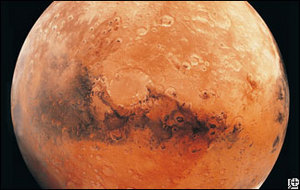 |
| ©Unknown |
| Missing Magnetic Field |
But that may just be part of the story.
A team of researchers led by Jafar Arkani-Hamed of the University of
Toronto in Canada believe a large asteroid circling the planet set up a
gravitational tug-of-war that got Mars' core churning. Eventually, the
asteroid lost its grip and crashed into its parent planet. Mars paid a
dear price as well. Without the tidal forces, the planet's core lost
its momentum, killing off the magnetic field.
What remain are patches of strong magnetic imprints in the oldest
parts of Mars' crust. Because the fresher surface features are
magnetic-free, scientists believe Mars lost its shield about four
billion years ago.
What remain are patches of strong magnetic imprints in the oldest
parts of Mars' crust. Because the fresher surface features are
magnetic-free, scientists believe Mars lost its shield about four
billion years ago.
Laboratory tests and computer simulations by Arkani-Hamed and colleagues and published in the Journal of Geophysical Research last
month show a large asteroid circling about 46,000 miles above Mars
could have had a strong enough pull on Mars to coax its liquid core
into moving. The dynamic would have lasted about 400 million years
before the asteroid crashed, demagnetizing Mars.
"Once it impacted, there were no tidal forces anymore so it couldn't power the dynamo," Arkani-Hamed told Discovery News.
The theory could explain why Mars' vigorous core suddenly grew still.
"Maybe a core dynamo wasn't powered by convection, but by asteroid tidal forces," he said.
Walter Kiefer with the Lunar & Planetary Institute in Houston
follows the logic, but doesn't see how an asteroid as large as the one
needed to tug Mars' core would have been captured by the planet's
gravity in the first place.
"I just don't know how to dissipate the energy to get it into orbit
around Mars, " he said. "Until that step is made, it's hard for me to
regard this as the right model."
The loss of Mars' magnetic field may have played a critical role in
the planet's evolution from the warm and wet world scientists suspect
it was into the cold, dry desert that exists today.
Magnetic fields, similar to Earth's, protect planets from cosmic
rays. They also help maintain the atmosphere by shielding molecules
from solar radiation.
Siberia forest blast captivates Wollongong scientist
Brett Cox
Illawarra Mercury News
Fri, 25 Jul 2008 10:39 EDT
It's a question that has had scientists arguing for 100 years.
Now, after many came together for conferences a century after the "Tunguska Event" in a Siberian Forest, the arguments continue.
On June 30, 1908, a blast, hundreds of times more powerful than the
Hiroshima atomic bomb, destroyed about 2000sq km of forest but left no
obvious crater.
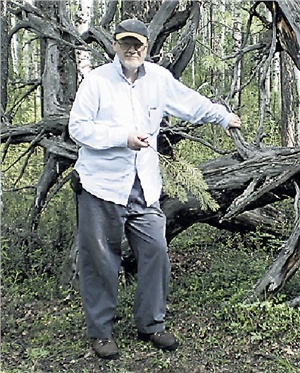 |
| ©Illawarra Mercury News |
| Wollongong academic Ted Bryant at the Tunguska site. |
Ted Bryant, Associate Dean of the Science Faculty at the University
of Wollongong, was one of a number of scientists from around the world
to converge on the area in recent weeks. He took part in one of four
conferences where scientists gave presentations.
There are 28 theories as to how the forest damage was caused,
ranging from a giant UFO to an underground volcano detonated by a
physicist harnessing electric charges in New York.
Professor Bryant is part of the largest group, who believe that a meteor exploded over the forest.
He stayed in Krasnoyarsk with colleagues from the Holocene Impact
Working Group, a collective of scientists who believe meteorite impacts
on Earth are more common than previously thought.
His group has discovered 15 possible ocean impact craters around the
globe, many in shallow water, leading them to believe there are
probably many more in deeper waters. The group also studies what it
believes are land tsunami deposits from the impacts.
Prof Bryant says there is much passion in Russia, particularly, as scientists argue their cases over the Tunguska Event.
"There was funding from a billionaire worth about $140,000 for research arguing it was caused by a spacecraft," he said.
Prof Bryant travelled 30km into the impact zone by helicopter,
camping in cabins built by the first scientists to venture there in
1928.
"Had it occurred over a city like Sydney, it would have destroyed
the city," he said. "The picture with me in it shows the overturned
roots of one of the trees blown down over 100 years ago.
"The (first scientists) found all the trees at this site were dead
and standing up, because they were at the centre of the blast - very
much like the building left standing beneath the epicentre of the
Hiroshima atomic bomb blast.
"Trees were burnt on one side by radiation from the direction the
meteorite entered the atmosphere. The following shock wave immediately
extinguished any flames, leaving partially burnt trunks."
Some Russian scientists argue against a meteorite theory as there are no fragments and no crater.
And some scientists have been seeking what could be a small crater and deposits that did not break up in the atmosphere.
Hit or Miss? Asteroid Apophis heading our way
Russia Today
Fri, 25 Jul 2008 16:46 EDT
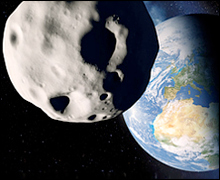 |
| ©Unknown |
Astronomers are battling to work out the trajectory of an asteroid
that will cause havoc if it hits the Earth in 2036. Called Apophis, the
giant meteor is hurtling through space at 10km per second. Scientists
are warning that an impact would be far more devastating than the
atomic bomb dropped on Hiroshima at the end of WW2.
At the Zvenigorod Observatory near Moscow, space researchers keep
watch on cosmic bodies and study known meteorites to understand their
size and inner structure. They are tracking the path of the asteroid
Apophis as well. They aim to determine how real the danger is but that
will only be clear in a decade's time.
Astronomer Sergey Barabanov explains the predicted course of events:
"The critical moment will be in 2029, when Apophis passes so close to
Earth that it will be visible to the naked eye. The consequence of this
fly-by will tell us whether it will come back again and collide with us
in 2036," he said.
If Apophis passes through a particular point in space called a keyhole the Earth's gravity may change its course for the worst.
In ancient Egypt, Apophis was the spirit of evil and destruction, a
snakelike demon determined to plunge the world into eternal darkness. A
fitting name, then, for a menace that could potentially cause
devastating global damage.
Nasa estimates the blast caused by Apophis would be a 100,000 times
more powerful than the bomb dropped on Hiroshima at the end of WW2.
It would also be more destructive than Siberia's Tunguska event of
100 years ago. That is thought to have been caused by a small space
rock explosion and this impact is the largest in Earth's recent
history. It wreaked havoc on a vast area, wiping out 80 million trees.
Ideas on how to deflect an asteroid range from blowing it up to sending a spacecraft to nudge it off its path.
Anatoly Zaitsev from the Moscow-based Planetary Defence Centre says we need to develop "a planetary protection system."
"There's no point in discovering these objects if we don't protect
ourselves from them. But we also need better observation techniques. As
it's difficult to track objects from the ground, I think a space
observation platform would be the best option," Zaitsev said.
Meanwhile, Russia has offered to launch a space probe to plant a
radio transmitter on Apophis so its orbit can be more accurately
tracked.
Ex-Astronaut Slams Asteroid Plan
Sky News
Mon, 28 Jul 2008 09:05 EDT
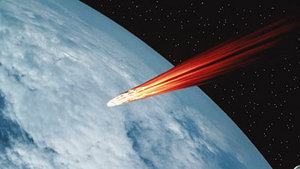 |
| ©Sky News |
A former Nasa astronaut claims plans to blast Earth-bound asteroids
out of space with nuclear weapons is not the best way to beat the
threat.
Apollo 9 legend Rusty Schweickart, who clocked up more than 240
hours in space, was responding to a Nasa report which said nukes were
the best option to avert a catastrophic asteroid collision with Earth.
He says most heavenly bodies could be redirected by ramming them from behind or towing them to safety with unmanned spacecraft.
Speaking at a public meeting in San Francisco, Mr Schweickart says
Nasa was put under political pressure to come up with the nuclear
missile solution.
The astronaut-turned-scientist, who piloted the lunar capsule in
Apollo 9, now heads the B612 Foundation, which promotes plans to alter
the course of asteroids hurtling towards Earth.
He says that at present we simply do not know what is heading towards us, but as new powerful telescopes come online, we will have a clearer picture.
"The good news is that we can do something about this," he said.
"The marriage of we human beings and the machines that we've created
are now at a level of capability which enables us to ... stop this
process from occurring."
In May 2005, he told the US Congress that a mission to attach a
device such as a radio transmitter to asteroid 99942 Apophis should be
a high priority.
It is estimated that this asteroid has a 1 in 6,000 probability of striking the Earth in the 21st Century.
The latest data indicates that the chance of Apophis impacting the Earth is 1 in 45,000 in 2036.
Comment: The notion that "we can do something about this" may be an indulgence in more than a little wishful thinking.
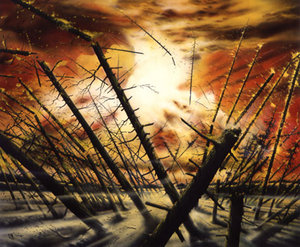
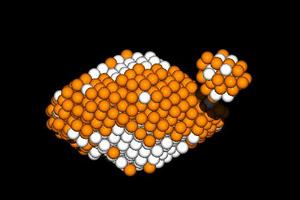
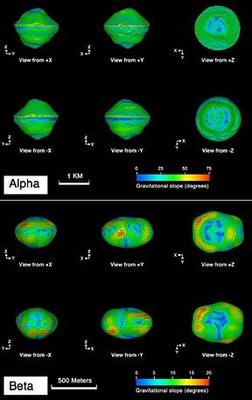
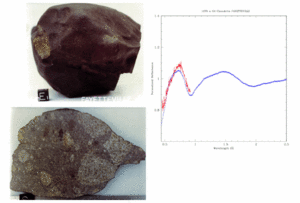
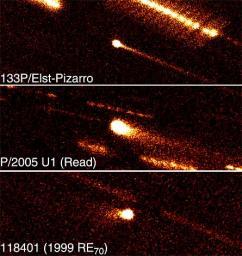
No comments:
Post a Comment